1lumen selects and reviews products personally. We may earn affiliate commissions through our links, which help support our testing.
Loop Universe SK01s LED review
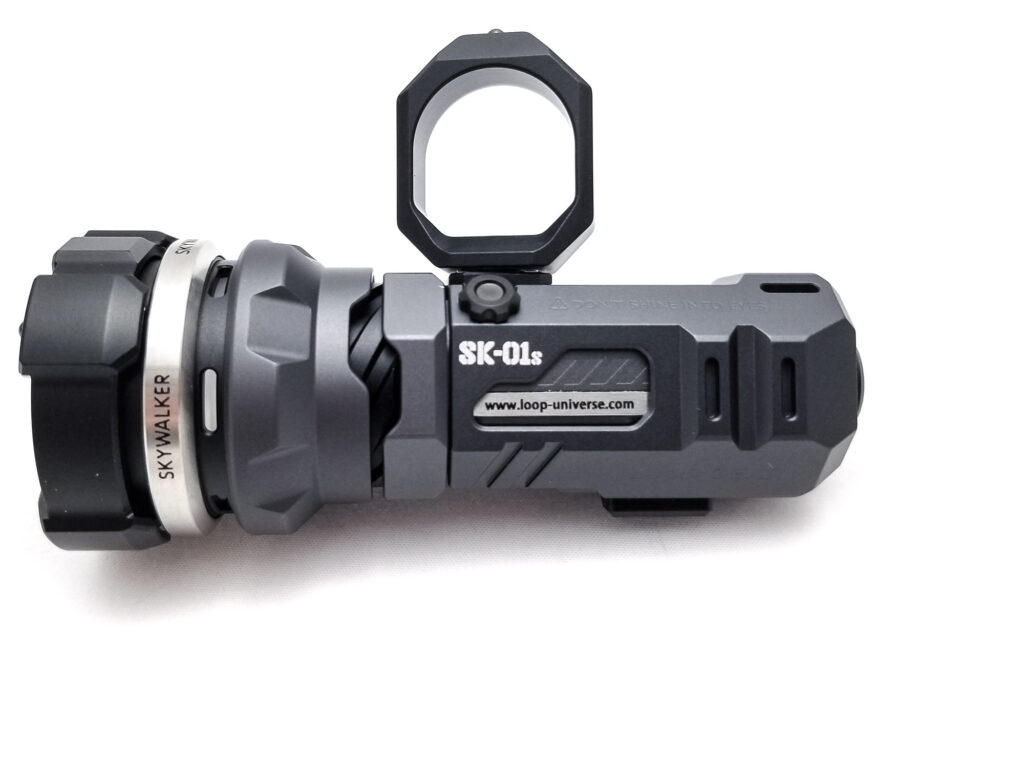
Loop Universe SK01s LED specs
| Brand & Model | Loop Universe SK01s LED |
|---|---|
| Flashlight category | Fidget EDC |
| LED | 1*Luminus SFT-40-W |
| Max. output | 1600 Lumens |
| Max. beam distance | 500 m |
| Max. beam intensity | 62,500 cd |
| Battery config. | 1*18350 |
| Onboard charging | Battery has USB type C |
| Main modes | 4 |
| Blinkies | Strobe |
| Waterproof | IP68 |
| Review publication date | September 2023 |
Review intro:
Something new landed on my desk today, and it’s pretty special as far as flashlights go. Marco reviewed the the LEP version of this particular light. This is of course the Loop Gear SK01s LED, affectionately dubbed Skywalker. Loop Gear was started by flashaholics (actually a chap named Bruce) and their quest for something different from the mainstream tube lights. The rest is history. This is the LED version of the Loop SK01s LEP, but other than the light source, it’s the same. That means toe-tappers, pen twirlers, habitual pen clickers, leg shakers, and chair squirmers can rejoice because the LED version has all the fidget features as the LEP version, including the fidget-y spinner deals, retractable, spring loaded body shroud, and funky aux LED switch lighting (with no less than 22 total lighting modes). Spec-wise, for a TIR-based pocket light it’s nothing special, but specs are a bit inconsequential for the Loop. Read on for why.
Package quality.
As a boutique brand, Loop packages their lights appropriately for the asking price and the SK01s came in a properly nice and very well-presented package. A sturdy box with magnetic closure lid with all the accessories laid out and organized nicely inside. Here’s what you get:
- Loop SK01s LED flashlight
- Loop branded 1100 mAh USB type C rechargeable 18350 battery
- 2 spare o-rings
- Two spare springs (one short, one long) for the retractable body shroud
- Spare metal disc
- Manual
- USB type C cable
- Warranty card
This is everything you need to get going with slinging photons (or fidgeting) and a comprehensive kit. It’s nice to see a battery included with integrated charging also since the SK01 doesn’t have a charge port. The battery was sitting at 0.26 volts, and there wasn’t an isolator in the tube between the contacts, so I suspect the parasitic draw on the battery drained it to the point the protection circuit tripped. The manual is one of the most unique ones I’ve seen! It’s totally appropriate for the theme of this light. However, you’re going to need exceptional eyesight to read it, since the font is probably 3 or 4 point, no joke. I nearly needed a magnifier to read the manual! Loop, please make the manual easier to read!
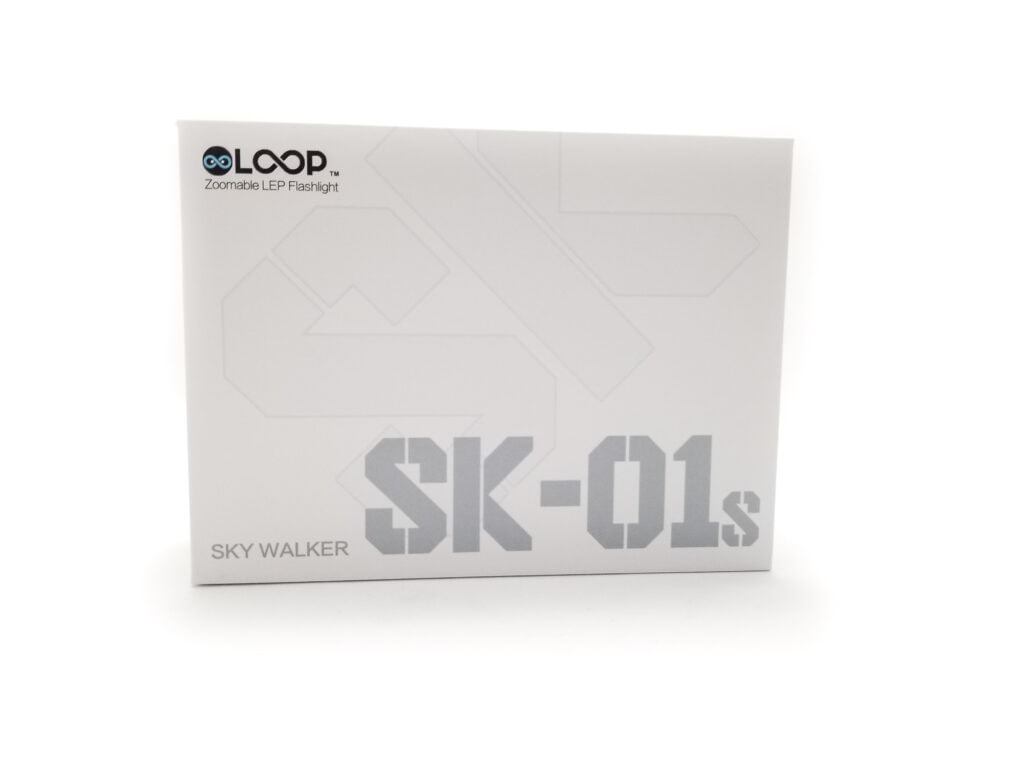
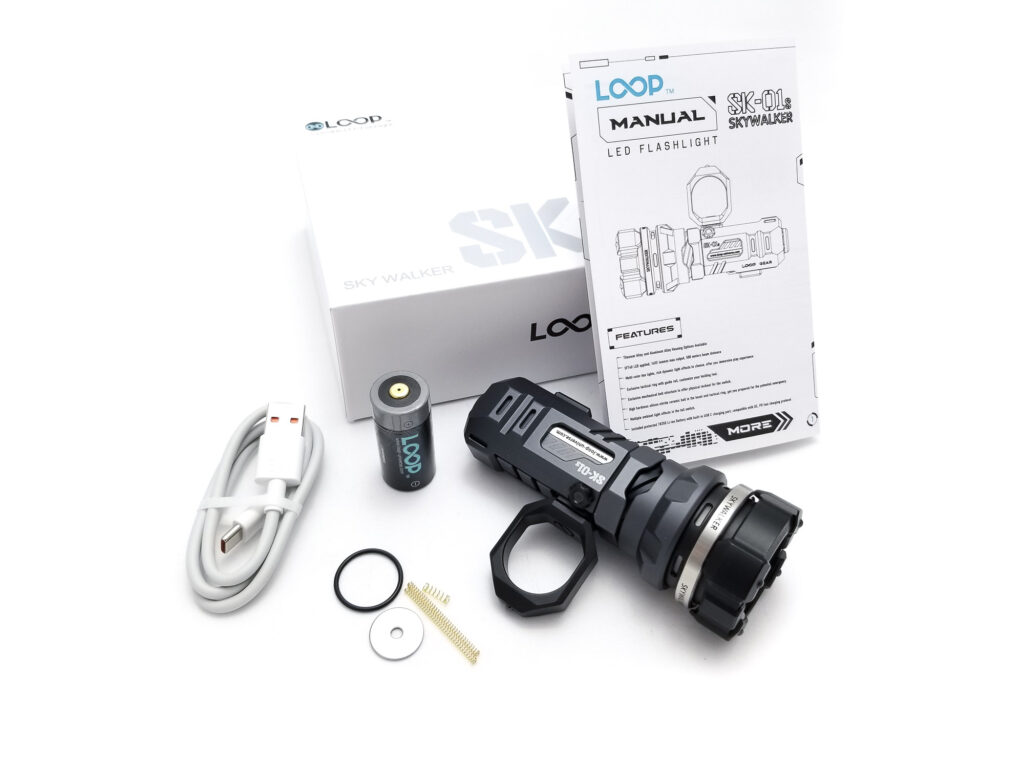
Flashlight in use
The SK01s LED is a subcompact 18350 light by design and function, but with a twist. As readers of Marco’s review of the LEP version will recall, this thing is all about the fidget features. The SK01s has three fidget features. The first spinner is aft of the bezel, and it’s a ball-bearing supported ring that spins.
The second is the grip ring mounted on the top of the battery tube. It has a ceramic glass breaking tip on the outer edge and it’s set in a ‘rail’ (more like a slot) that can be adjusted by loosening a flat head screw in the middle. It also has a ball bearing supported shaft and can be spun to your heart’s content. Both the bezel spinner and the grip ring have exceptionally smooth bearings, and even a slight flick sends them spinning for a long time. Yep…satisfying.
The third is a spring-loaded ‘bolt’ that slides over the battery tube and can be extended out over the tail and the rear e-switch for an effective mechanical lockout. It clicks in place and can be released by pushing a release button. It’s a cool feature, and firearms enthusiasts will appreciate the likeness to releasing the slide on a handgun.
The body is square, and has no shortage of gripping surfaces. There’s slots for tritium vials or glow tubes as well.
Pocket carry? In a word, no.
This is not a good EDC light. Here’s why. That grip ring sticks out too much, and the weight, overall bulk and largeness, as well as the fact if you bump your EDCs around, those moving parts could break. All that makes it unsuitable for EDC duty. However, if bulging pockets and sagging pants are your thing, then by all means EDC the SK01s.
There’s a single rear e-switch for switching duties. The button has a clear red insert that looks like a marble, and features RGB LED backlighting (there’s also RGB aux LEDs under the optic). The switch button itself seems to be a finely sculptured black anodized aluminum unit, and sticks out about 3 mm, so it’s easy to find.
With the body extended, tail standing is stable.
Handling-wise, it feels big and heavy for an 18350 size light, and honestly, I didn’t really like the handling. The bolt isn’t securely locked to the body and has just enough slop to make gripping the light feel weird and unintuitive. Using the grip ring helped with stability, but I never quite got used to it. The switch, while it worked fine and had a nice clicky action, had some lateral movement. It made it feel weird and manipulating the switch without using the grip ring wasn’t intuitive and just felt sloppy. While the aux LEDs in the head aren’t active when the light is on, the tail switch aux LEDs are.
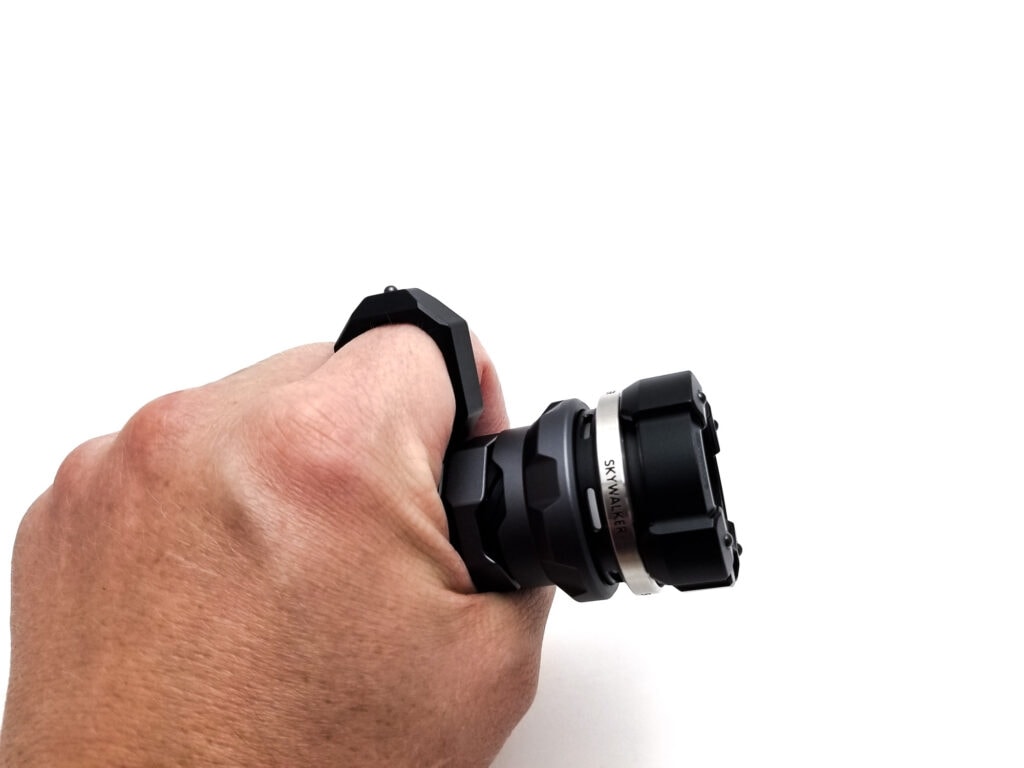
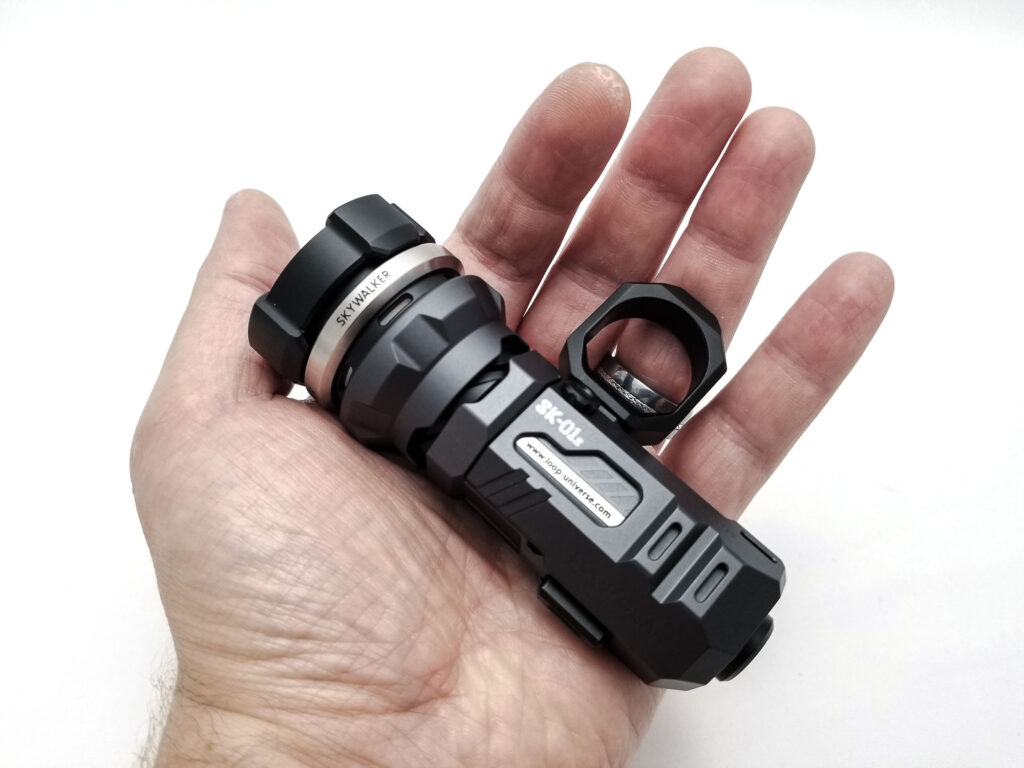
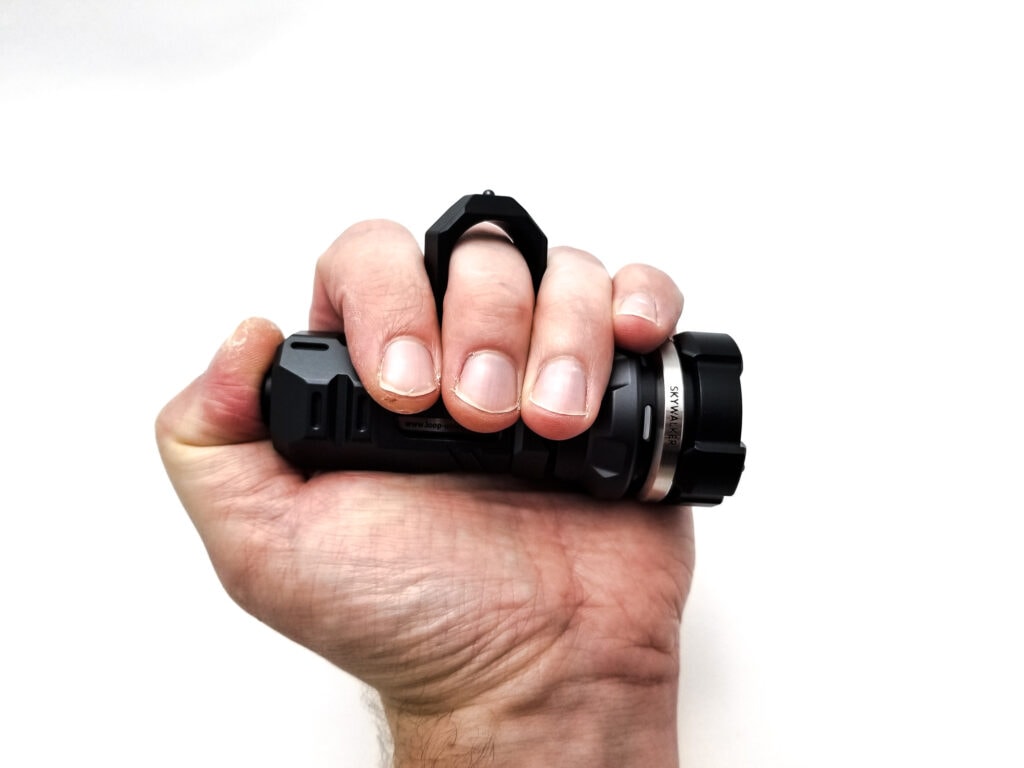
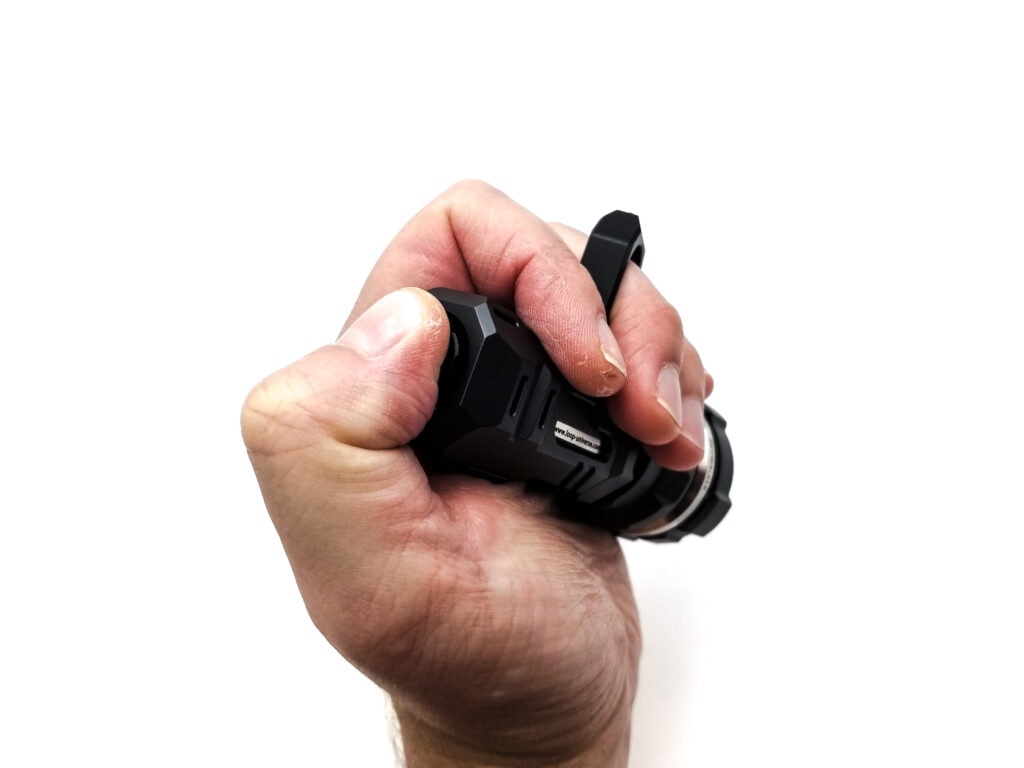
Build Quality and Warranty
Quality here is very, very good! I didn’t notice any issues with the fit and finish. There’s a lot going on with this light, and it has a lot of moving parts with pretty meticulous attention to detail! The LEP version was definitely not a budget light, and neither is the LED version. It’s a bit cheaper, but still retails for about $200 US. That’s expensive, but you’re paying extra for the intricacies and ‘play’ features.
The SK01s m is milled from 6061-T6 aluminum, and the machining is super-tidy, and every edge has been knocked down and smoothed. The engraving and silk screen text is super sharp as well, and all the parts fit together perfectly, and despite all the moving parts, the fit and finish are great. The finish is unspecified anodizing, that’s a mix between semi and matte. It’s nicely done and Loop offers 3 finish choices: Titanium black, titanium silver, and aluminum gray. The sample light came in aluminum alloy gray, and I love it. The contrasting matte finish with the shiny features and black anodization of the bezel, grip ring, and a small section of the head under the spinner ring looks awesome. The finish is spec’d as type III HA. it’s nicely matte, and a bit shiny/slippery, but not overly so. It’s holding up good so far.
The head unscrews and the battery loads from the front. The bolt can also be removed by unscrewing two fasteners that look a bit like oil or gas filler caps. Cool! Once they’re out, the bolt can be pulled rearward for removal. A word of caution for the curious: When unscrewing the two retaining screws the threads are very short and they will easily fall out if you over do it. If the bolt comes out, a teeny gold return spring will fall out, and trust me, it will get lost (ask me how I know that!). There’s a very short, gold plated spring on for the driver contact with contacts for the signal tube, and there’s a coil spring in the tail. Nice. The only threads are on the head,augmented with a single o-ring. They’re extremely fine pitched triangular cut units and they are exceedingly short. I measured them at 3 mm long. Even though they’re fine and short, I didn’t feel like they were going to cross thread, so they’re well designed.
Warranty? Loop Universe offers a 5-year warranty on all products for workmanship and factory defects. Batteries are excluded, as is intentional damage from modding, etc. All the usual stuff.
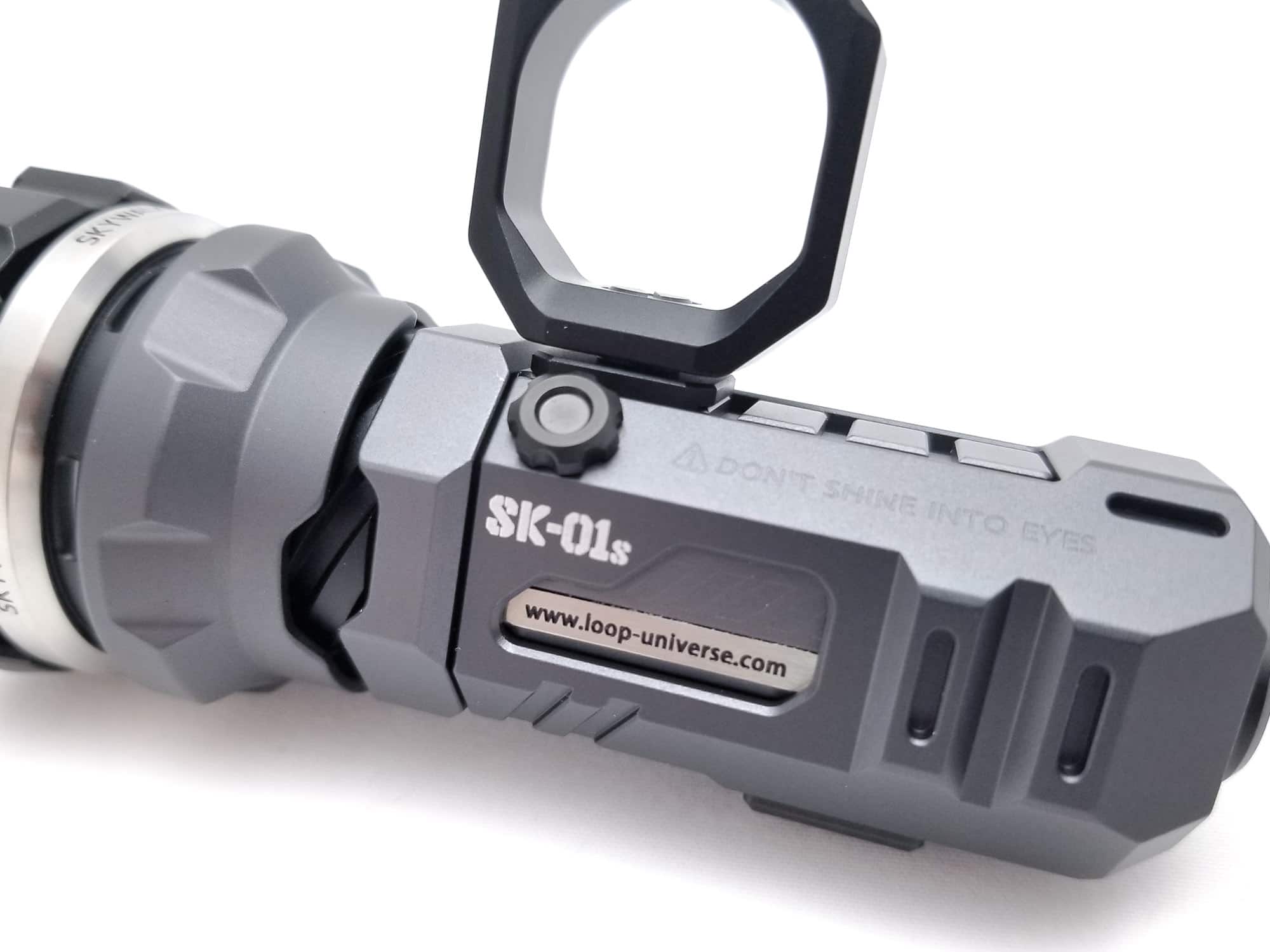
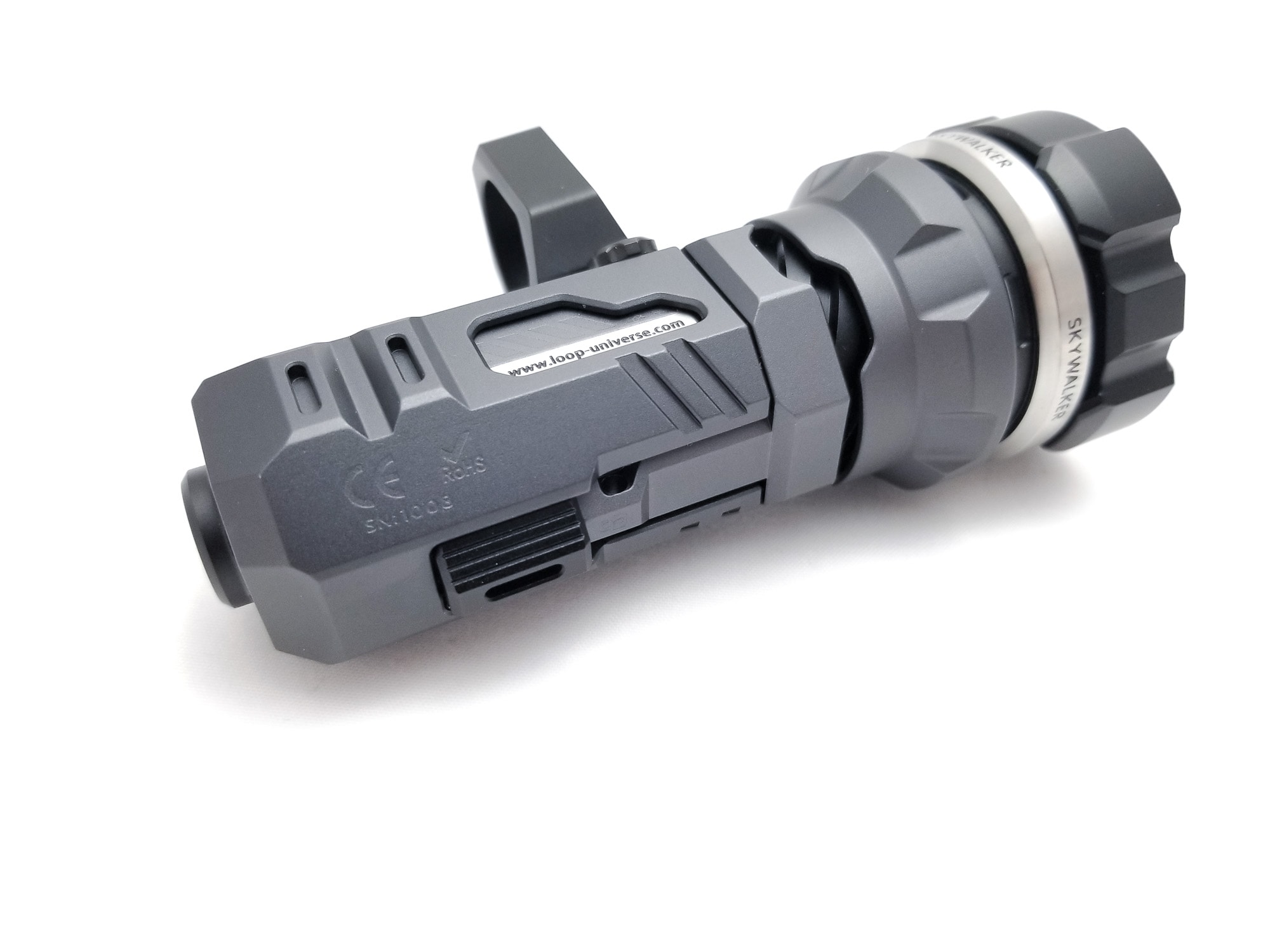

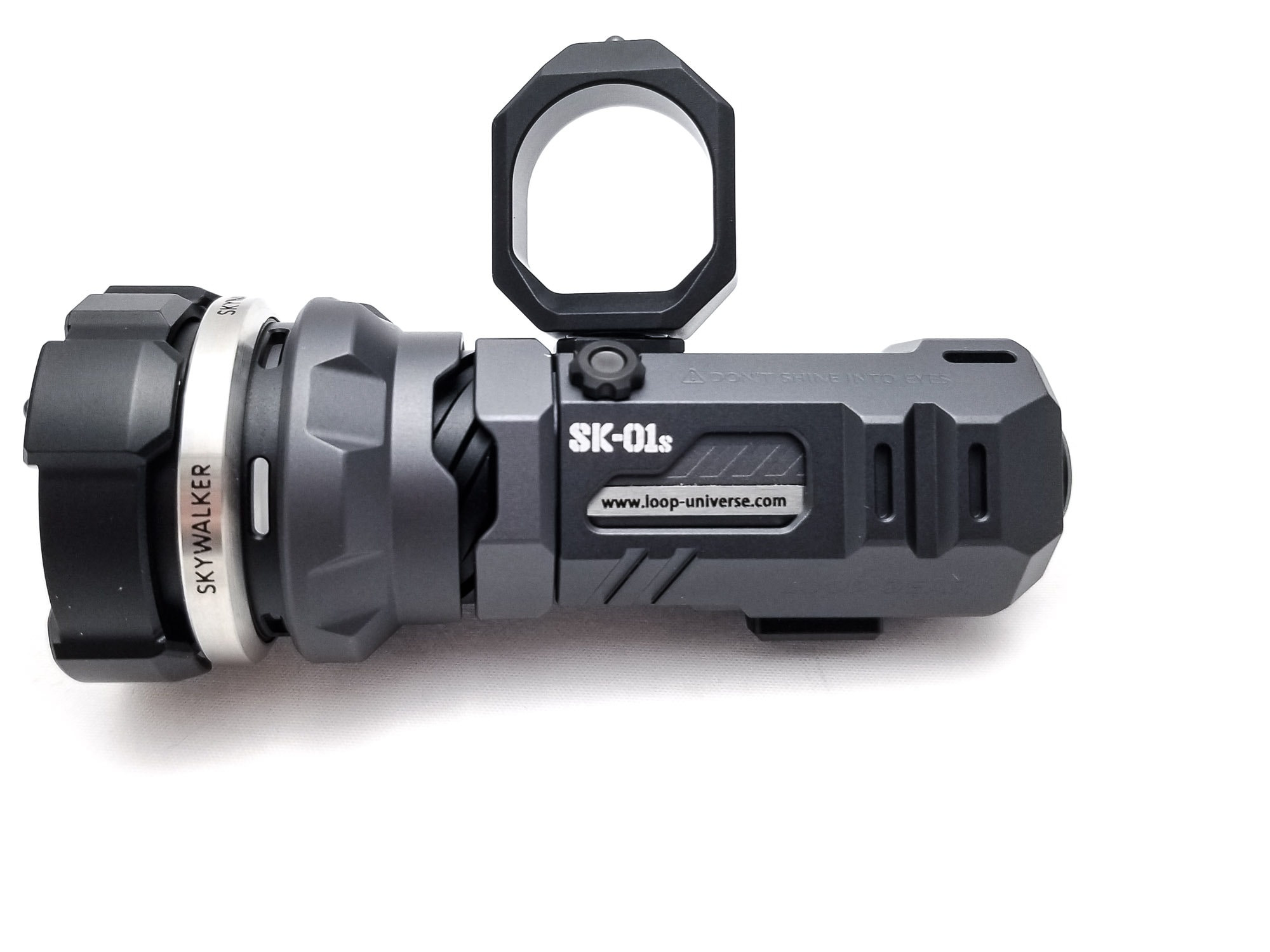
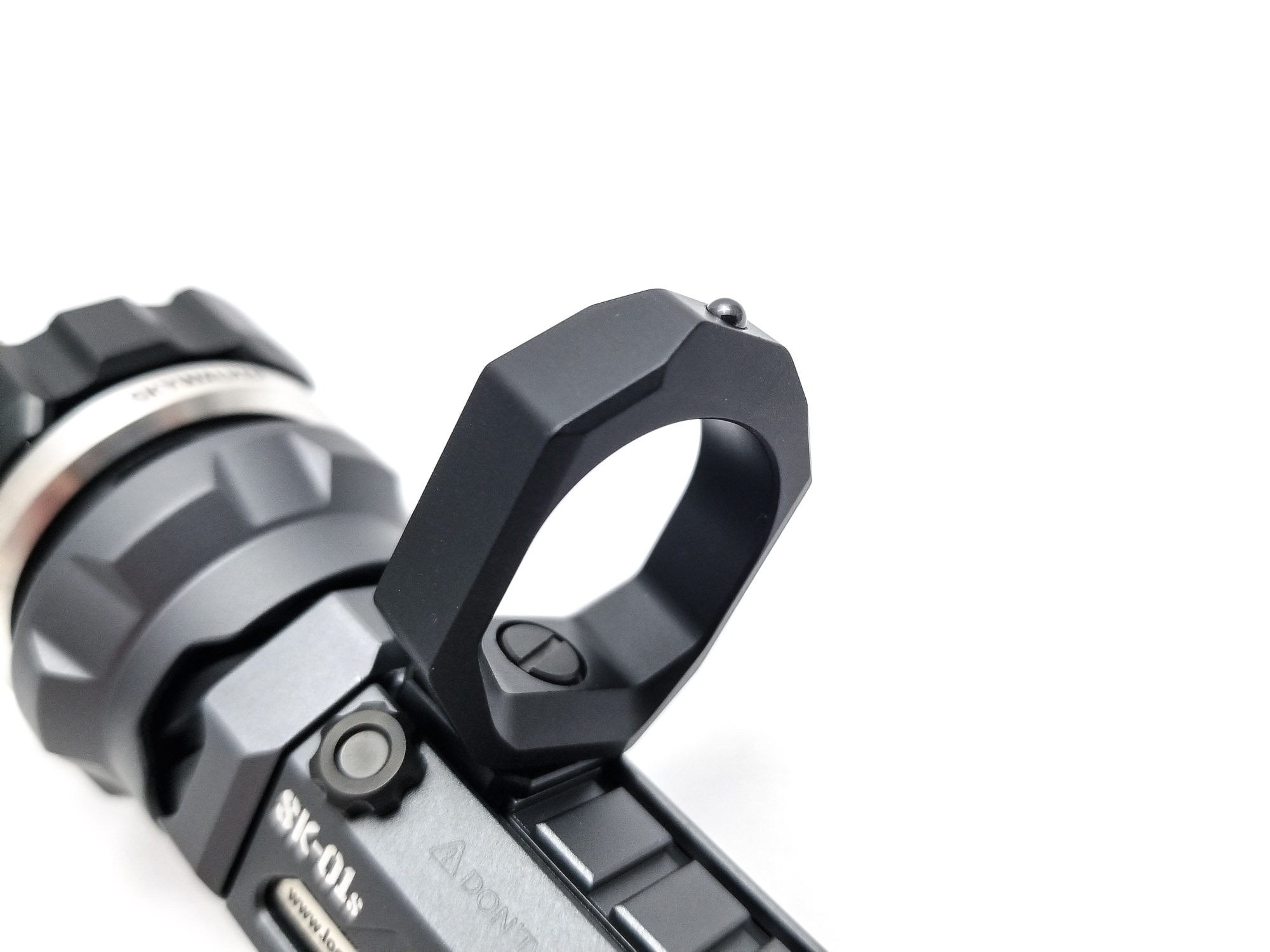
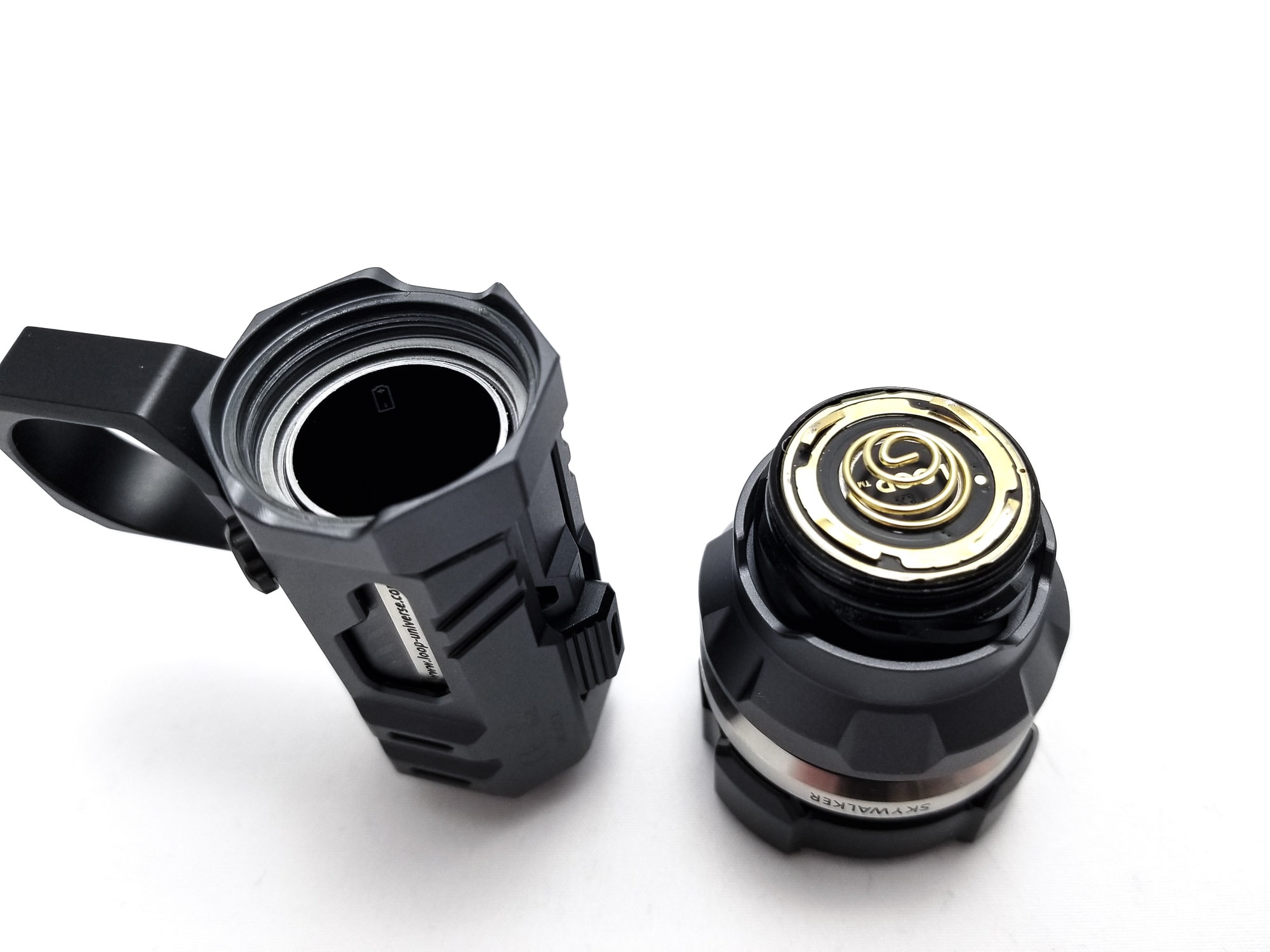
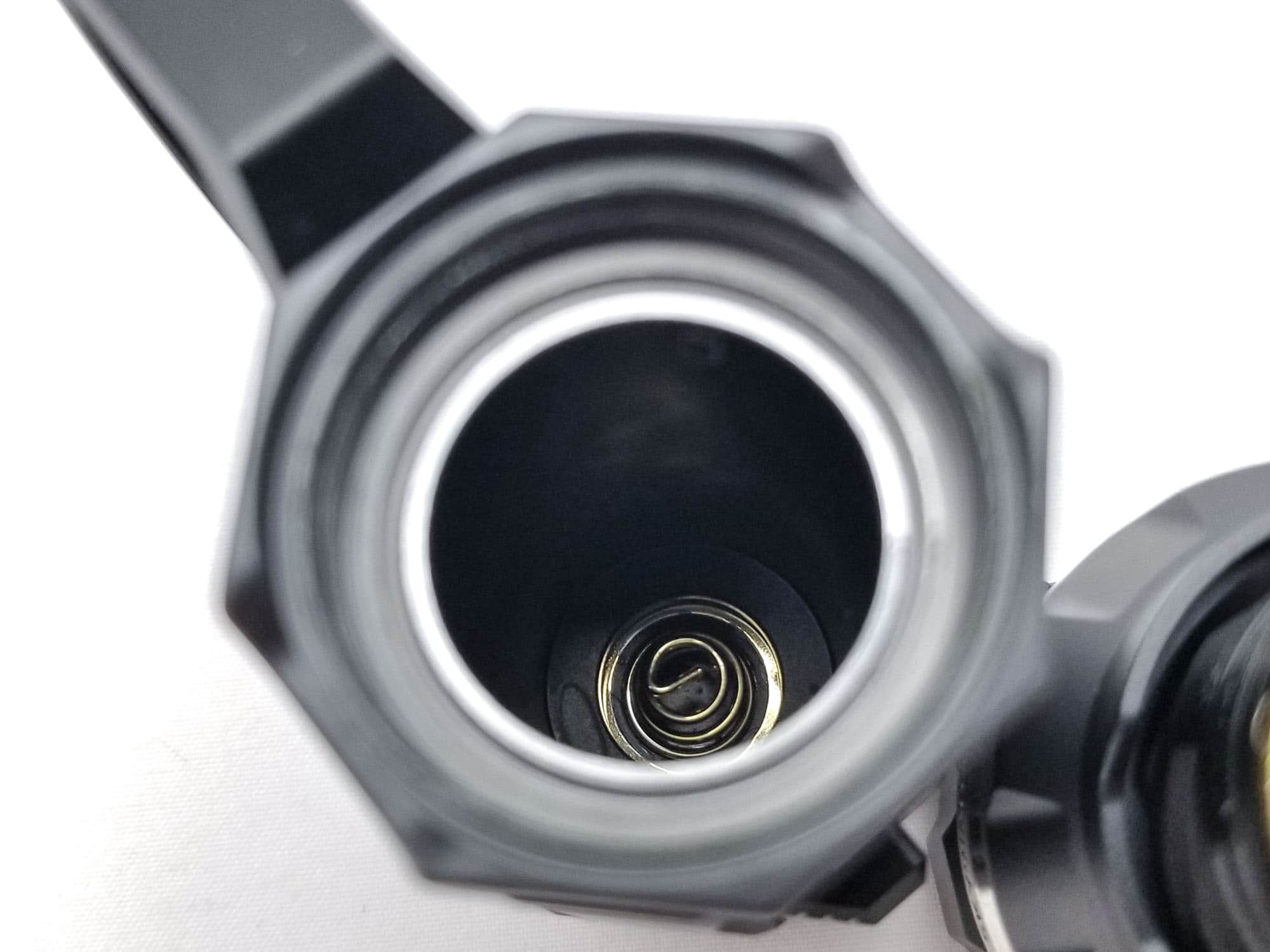
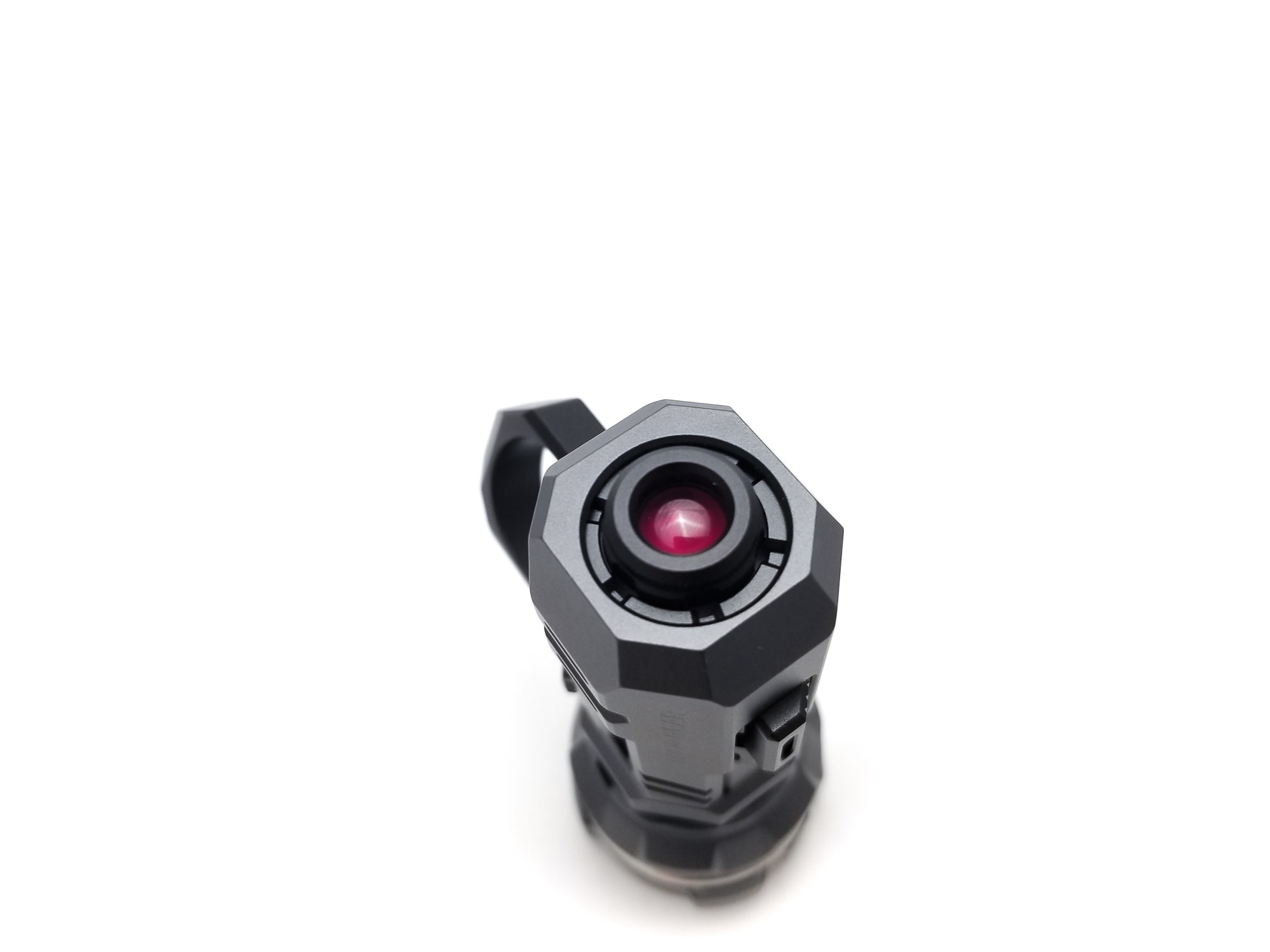
LED, Lens, Bezel, Beam, and Reflector
Loop is forthright about their LED here, the Luminus SFT-40-W. This is a domeless LED that has been in service for a couple years now, and has proven itself as the premier high intensity 5050 footprint LED. It’s cool white only, between 6000 and 6200 K.
The bezel looks to be aluminum. It’s properly chonky as well, and has 4 glass breaking zirconium balls on the tips of the crenulations. The inner part has what looks like threads. Maybe for a filter or diffuser? Under the bezel is a plastic TIR optic. It’s not protected by a glass lens as far as I can tell, which is a bummer, but it’s nonetheless well protected by the beefy bezel which extends about 6 mm over the optic.
Optics help focus the light and minimize spill, and just like the Manker MC13 II, the beam is geared towards throw rather than general purpose. It has a tight hotspot with pretty decent spill and side illumination, and even though there’s an adequate amount of side illumination, I wouldn’t call it EDC-friendly. It’s also ‘dirty’ with some artifacts, something I don’t see often with TIRs. The Opple Lightmaster Pro has the CCT at 6671K, CRI Ra 69.3 on Turbo, 1 meter from the sensor. The duv is -0.0015.
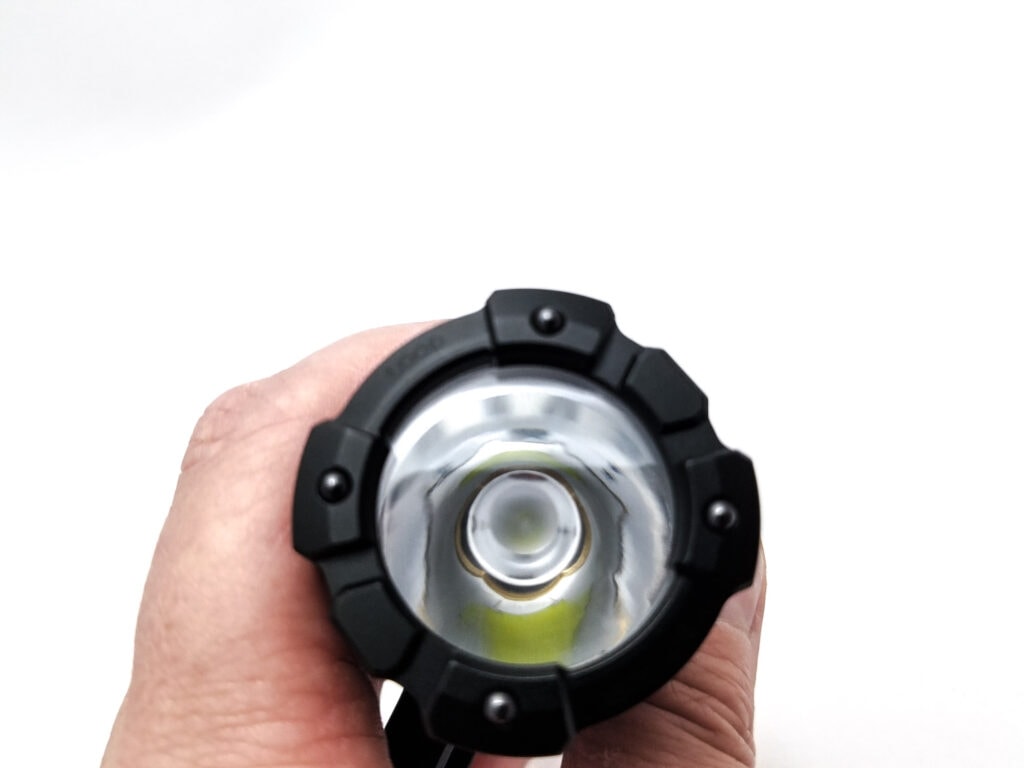
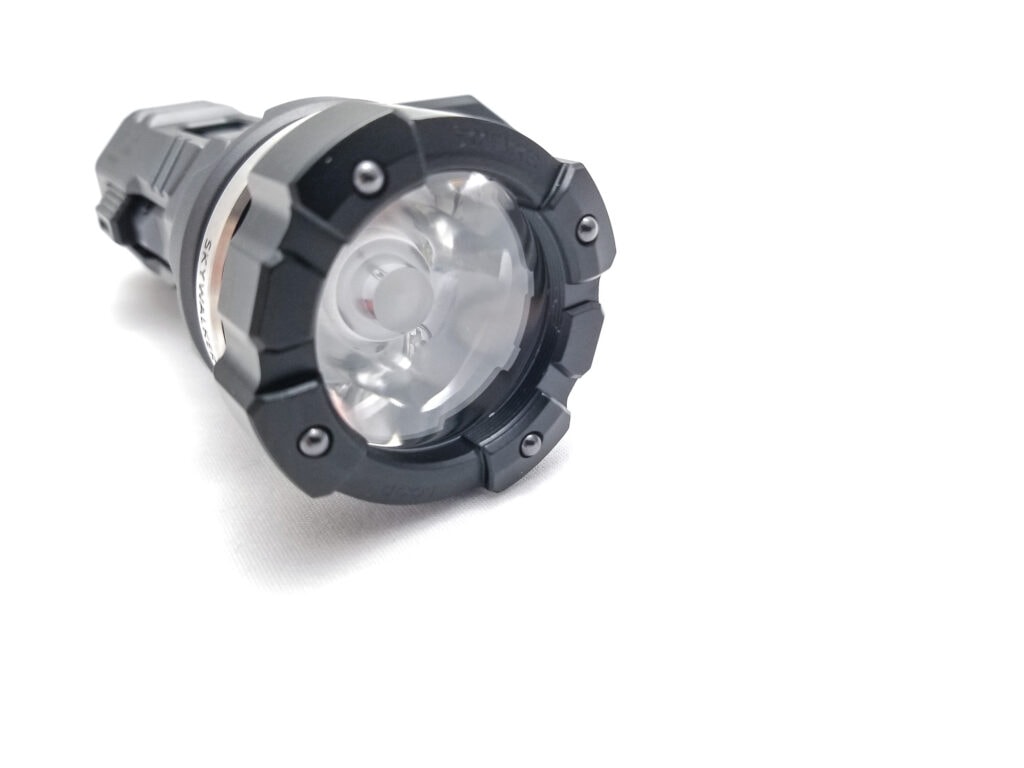

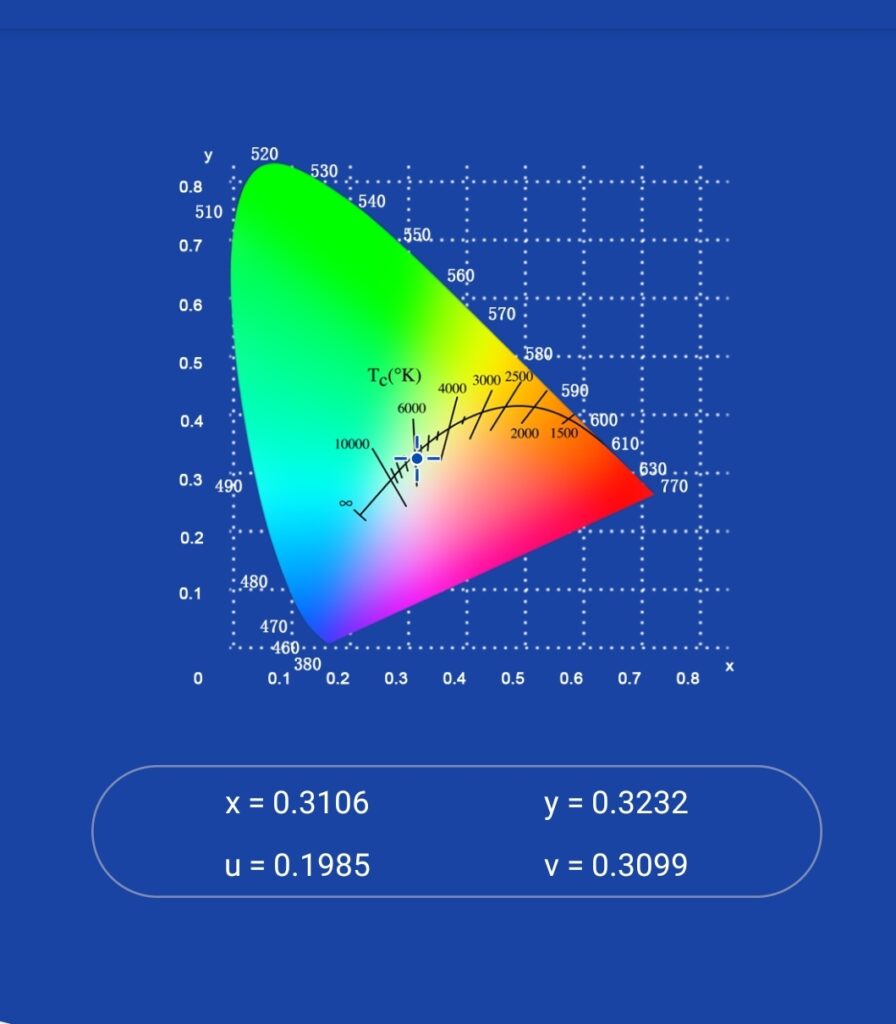
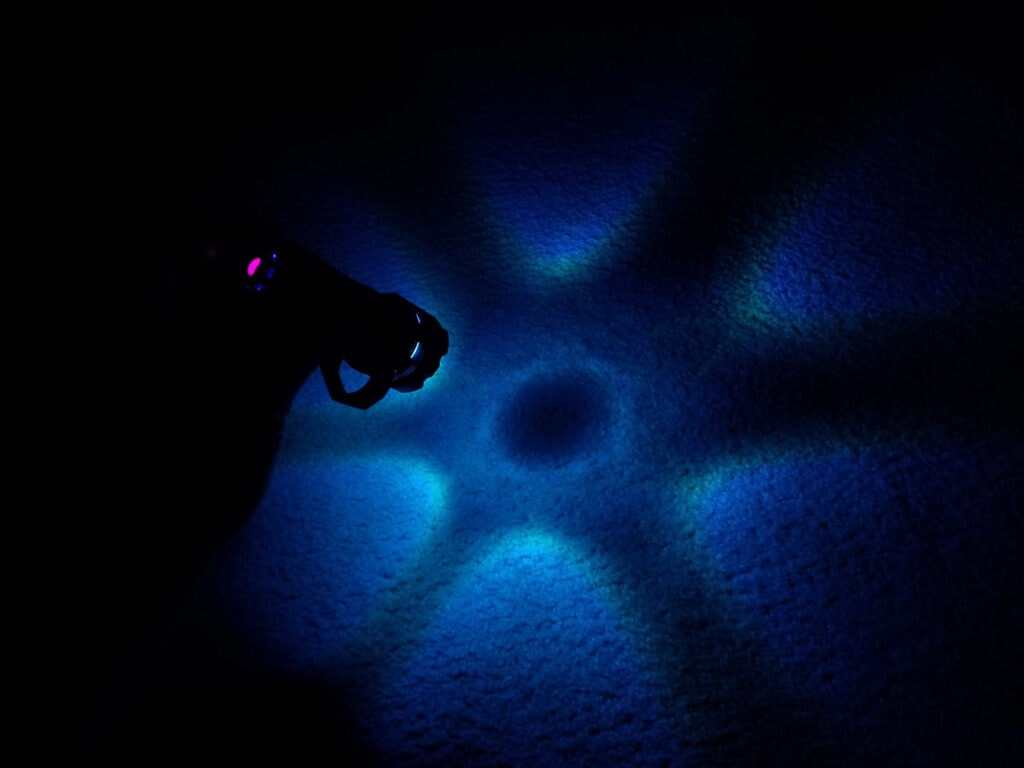
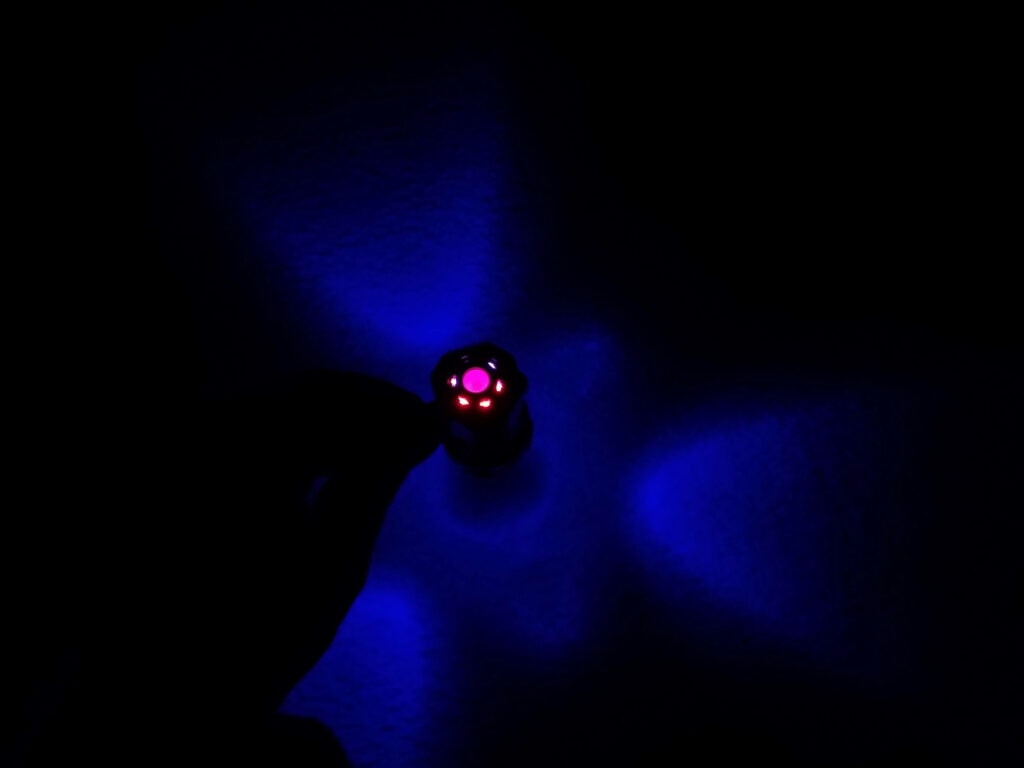
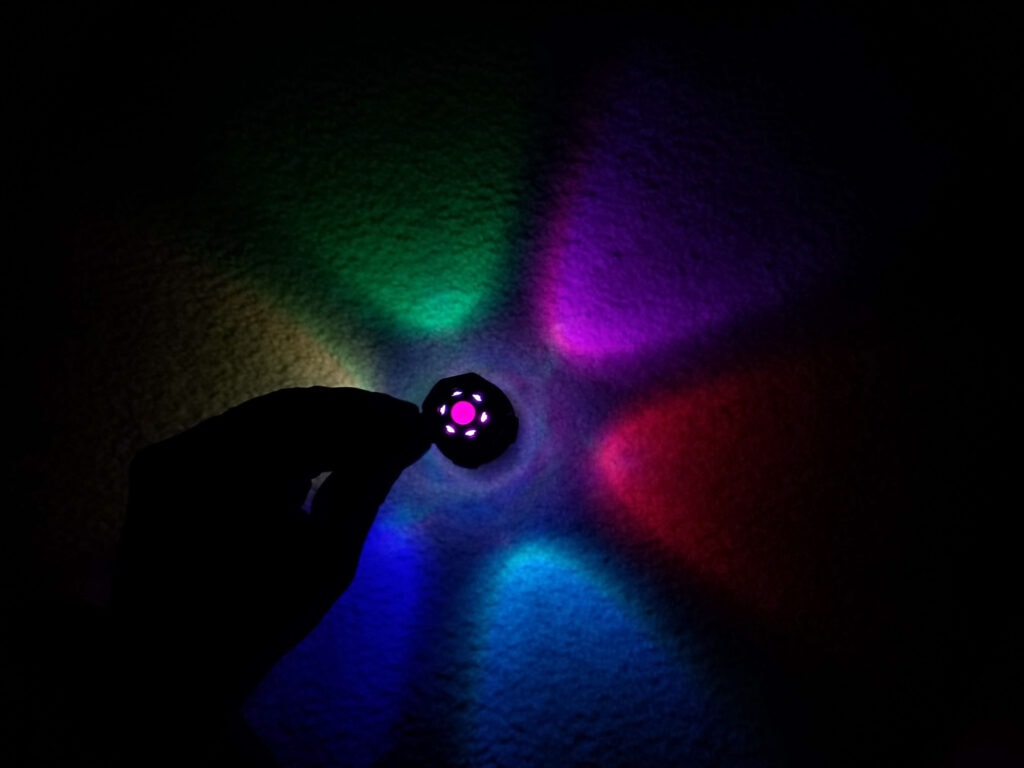
Dimensions and its competition
Dimensions:
| Loop SK01s LED | Millimeters | Inches |
|---|---|---|
| Length | 129 mm | 6 in |
| Head diameter | 35 mm | 1.3 in |
| Body | 28 mm | 1 in |
| Body at highest point | 71 mm | 2.8 in |
Dimensions are rounded to the nearest millimeter, and to the nearest tenth of an Inch.
The last figure is the total width including the grip ring.
Weight:
| Loop SK01s LED | Weight in grams | Weight in oz |
|---|---|---|
| With battery | 189 g | 6.7 oz |
| Without battery | 163 g | 5.7 oz |
Weight is rounded to the nearest gram, and to the nearest tenth of an oz.
Flashlight size comparison with its competition:
Group 1 left to right: Look SK01s LED, Manker MC13 II with 18350 tube, Emisar D1 v2, Thrunite T2
Group 2 left to right: Astrolux EA01, Acebeam L17, Loop SK01s LED
Group 3 top to bottom: Loop SK01s LED, Lumintop FWAA

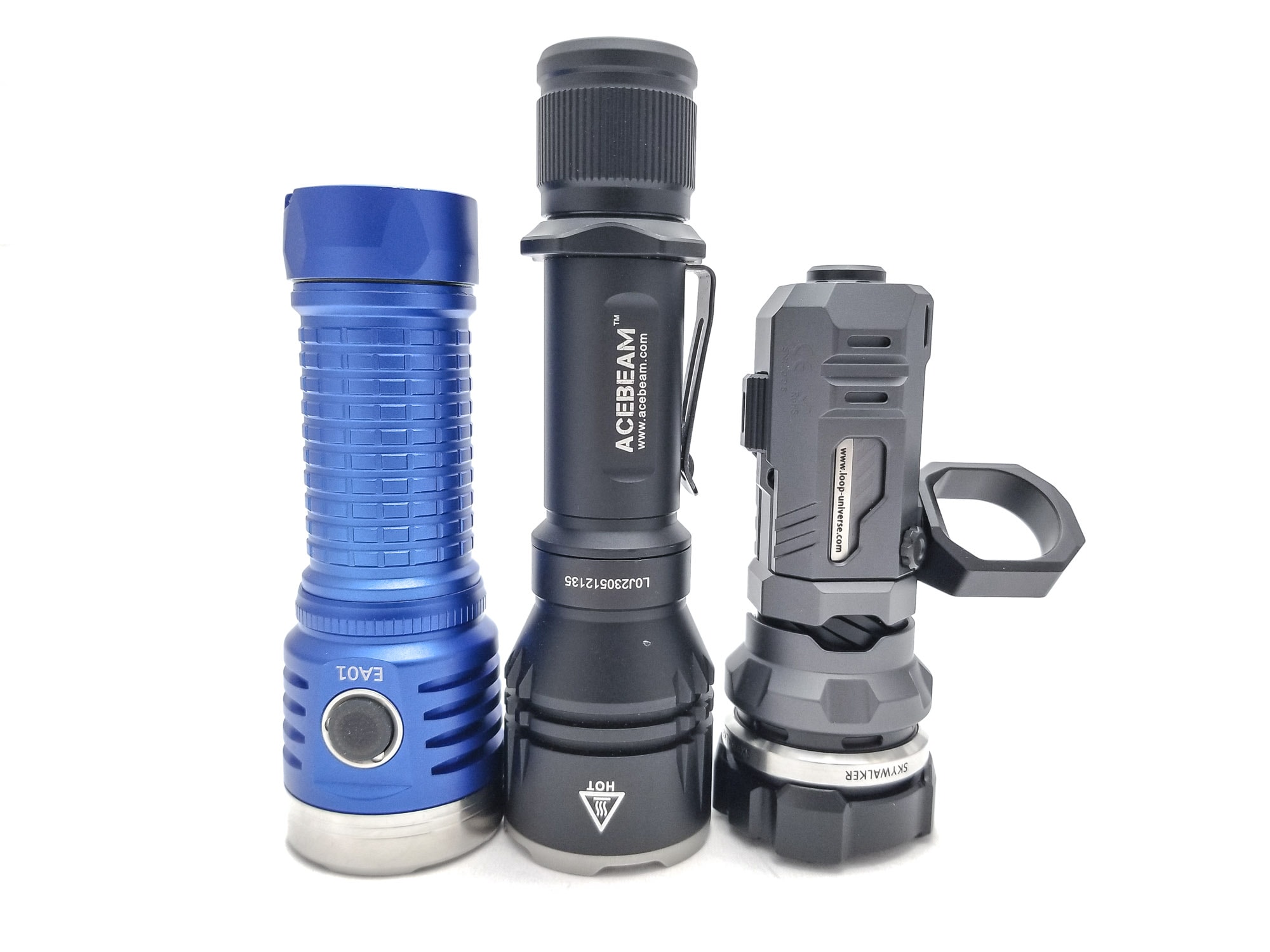
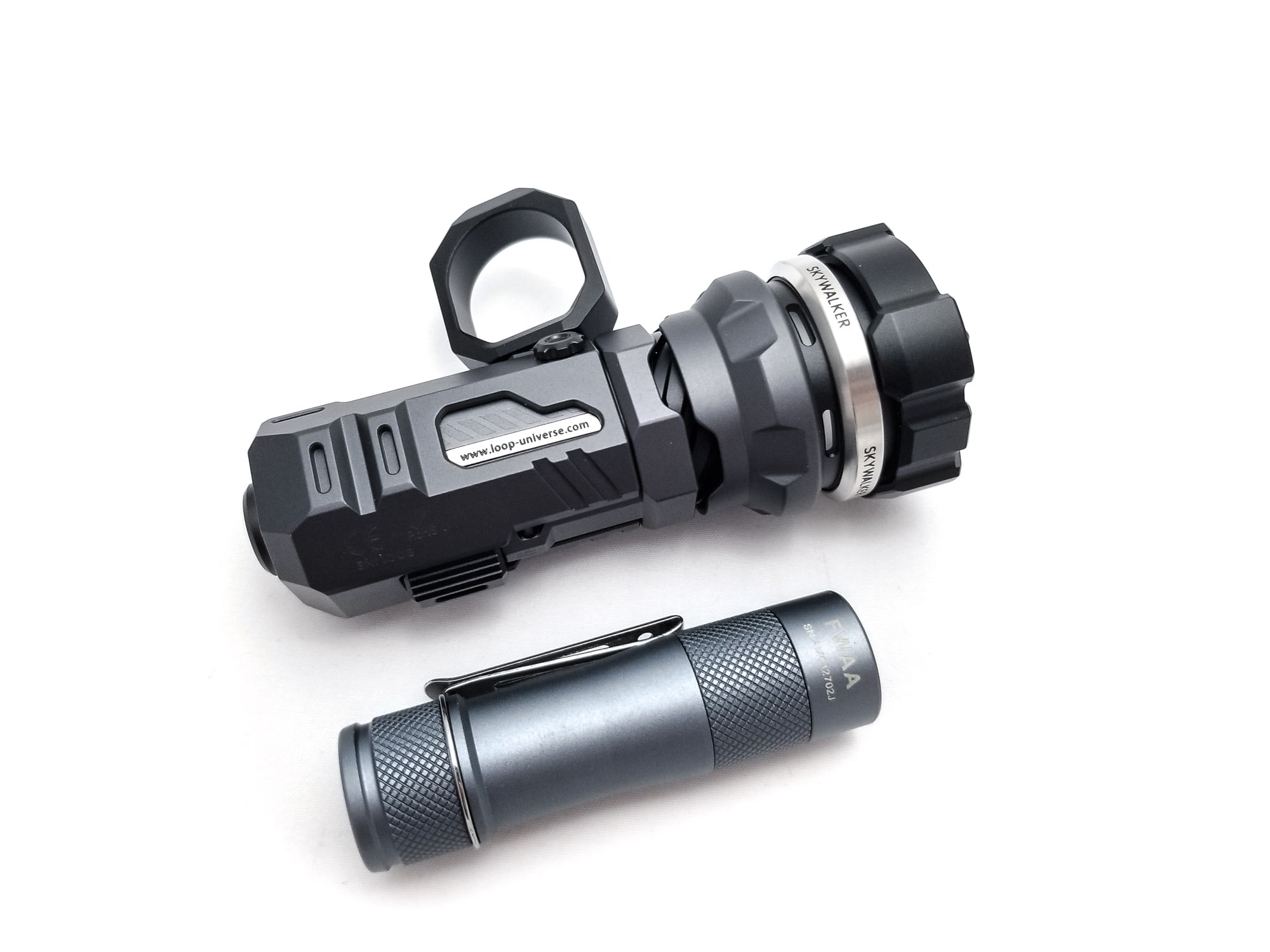
Loop Universe SK01s LED: User Interface and Driver
I’m not sure what kind of driver the SK01s is sporting, so we’ll let the runtime tests tell us.
The UI is dead simple with 4 modes plus Strobe. It’s super easy to use and negotiate and incorporates all the convenience features of a modern flashlight UI.
Available Modes:
- Eco, Low, High, Turbo
Available blinky modes:
- Strobe
From OFF:
- Single click switch: Turns on in last memorized mode
- Press and hold switch: Eco
- Press and hold switch more than 2 seconds: Activates the ambient lighting feature
- Double-click switch: Turbo
- Triple click switch: Strobe
From ON:
- Click switch: Turns off
- Press and hold switch: Advances through the modes: L, H, L
Mode memory:
- Remembers last brightness level. Turbo and Strobe are not memorized
Shortcuts:
- Triple click: Strobe
- Press and hold from off: Eco
- Double click: Turbo
- Double click from Turbo: Strobe
Strobe/blinkies
- Strobe
Lock-out mode:
- To lockout the light, from OFF, click the switch 4 times. The aux switch LEDs will do a spinning and blinking pattern before turning off (about 4 seconds worth). To unlock, repeat and the light goes through another blink/spin pattern again (about 4 seconds), then unlocks to what looks like Low mode. The light can also be manually locked out with the bolt on the body since it effectively isolates the switch from being pressed. I sort of prefer that method! The aux LED lighting modes are available in lockout. Pressing and holding the switch for 1 second cycles through them.
Shortcuts:
- Double click from on/off: Turbo
- Triple click from on/off: Strobe
Ambient Lighting Effects Modes:
- There’s a total of 22 RGB lighting effects available for the aux LEDs: 5 for the tail switch LEDs, and 17 for the head-mounted aux LEDs (under the TIR optic). To access the ambient lighting modes, from off, press and hold the switch for 2 seconds. To switch between the modes, long press the switch again for 1 second. Holding the switch down also cycles through the modes. Keeping track of the order? Forget it.
- Available modes:
- One of each for a breathing and a spinning effect in: Purple, Ice blue, Yellow, Blue, Green, and Red.
- Multiple alternating RGB colors for the head LEDs and a single RGB scheme for the switch LEDs. The head LEDs get a spinning RGB effect, a breathing RGB effect, a multicolor spinning effect, and a disco mode
- The aux LEDs in the switch turn on when the light is on, but the head mounted aux LEDs are not active
PWM
- Visible with my camera, but very fast PWM for the Low and High mode. Turbo’s PWM was not visible.
Additional/summary info on the UI:
- This is a great UI overall with nothing to really complain about. It’s easy to negotiate and easy to learn. I like how Strobe is hidden, but easily accessible. The aux lighting modes are a bit overwhelming though and I think a bit unnecessary and maybe a bit gimmicky. I appreciate Loop adding these though since it augments the uniqueness of the light, so I guess they’re appropriate here. Maybe tone it down on the brightness a bit though because these are the brightest aux LEDs I’ve ever encountered! In fact, the disco mode incorporates flashes from the main LED that are very bright and a bit obtrusive (and probably doesn’t help standby battery life either).
- The other issue is the electronic lockout. When unlocking the light, after the 4 clicks, the light doesn’t turn on if you press the button. You need to wait for the switch LEDs to do their thing and then the light turns on in what looks like Low mode. I’d have preferred it to turn on in Eco mode. Also, you can access the aux LED modes in lockout, which I’m on the fence about since lockout is supposed to lockout the light, right? It would be nice if the aux LEDs could be deactivated in lockout, but keep the switch LEDs on. Just saying.
Loop Universe SK01s Charging and batteries
The SK01s utilizes a 18350 li-ion battery. Loop includes an 1100 mAh button top USB type C rechargeable high drain battery. It has a protection board and supposedly supports QC and PD charging. The Sk01s isn’t limited to the stock battery though. It happily digested a VapCell M8 unprotected flat tops. I charged the battery on a 45W PD power supply with a C to C cable and saw about 1.3 A and 4.9 V, so about 10 watts. That’s a lot for a little battery! The button top has a central LED indicator (like Fenix and Cyansky) that’s red for charging, blue for fully charged. A USB A to C cable also worked. I definitely wouldn’t recommend charging this battery at QC or PD levels since that would shorten its lifespan, even with a protection board. The battery was sitting at about 4.18 volts after a charge cycle, and per the USB tester, it added 1162 mA in 1 hr. 14 minutes.
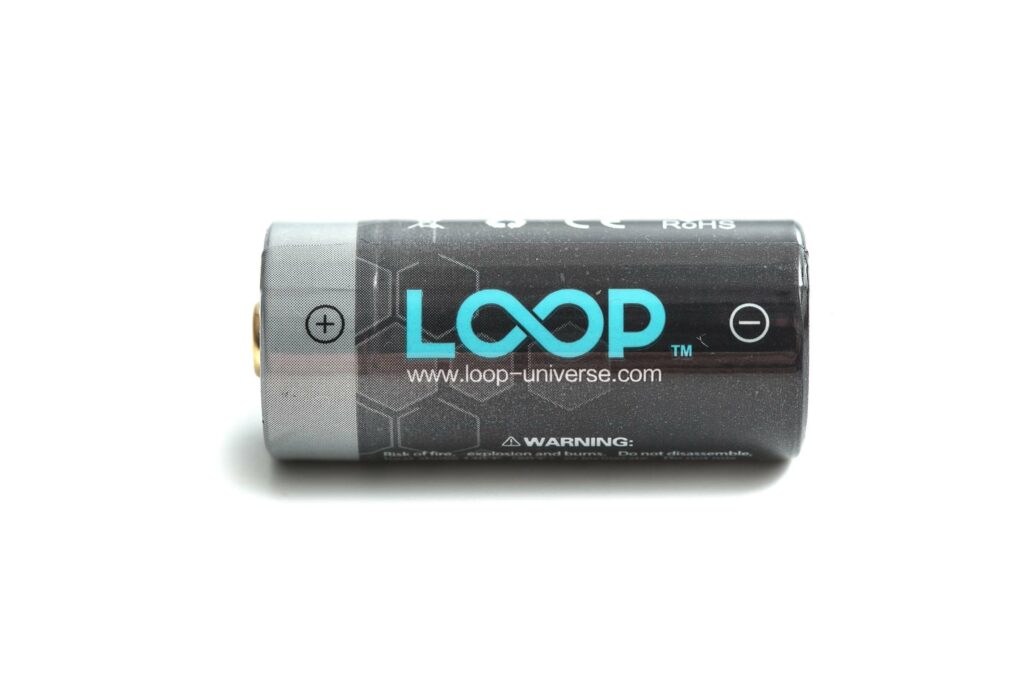
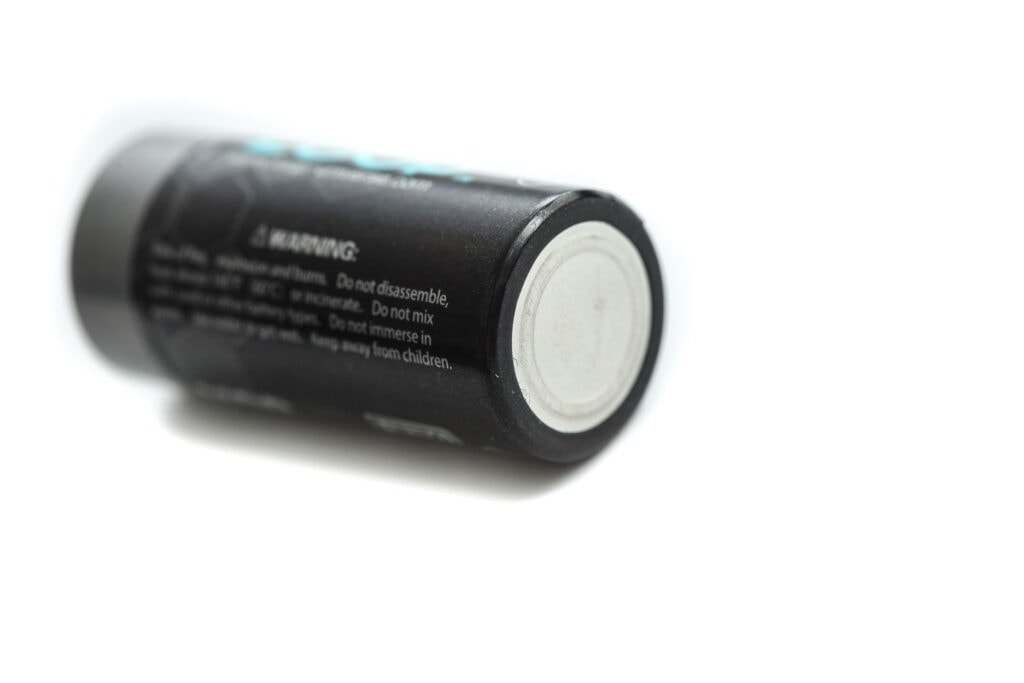
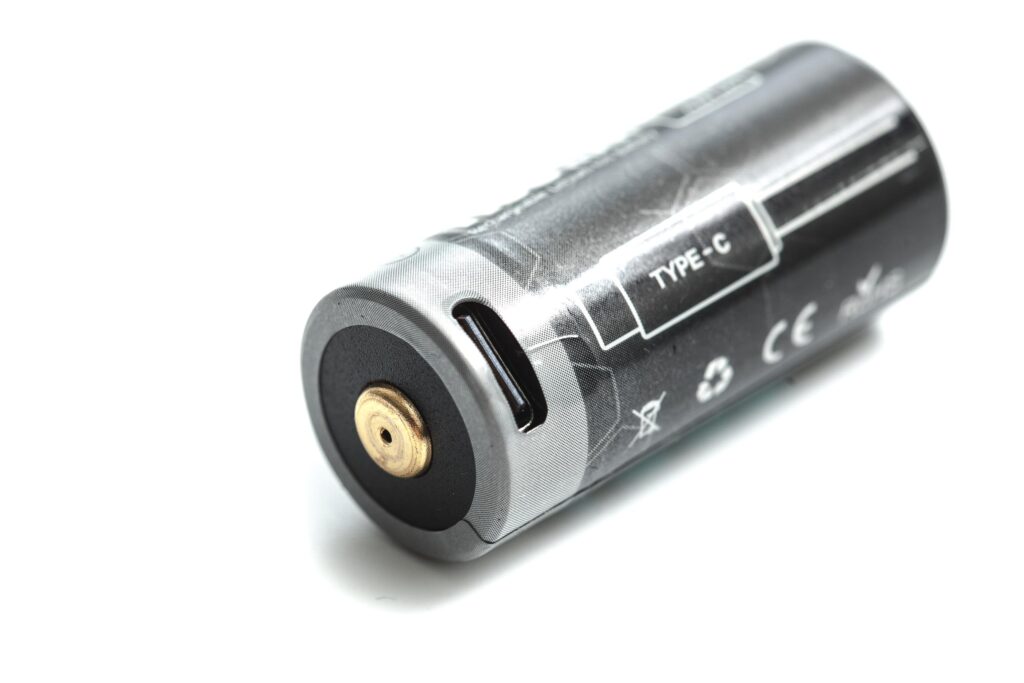
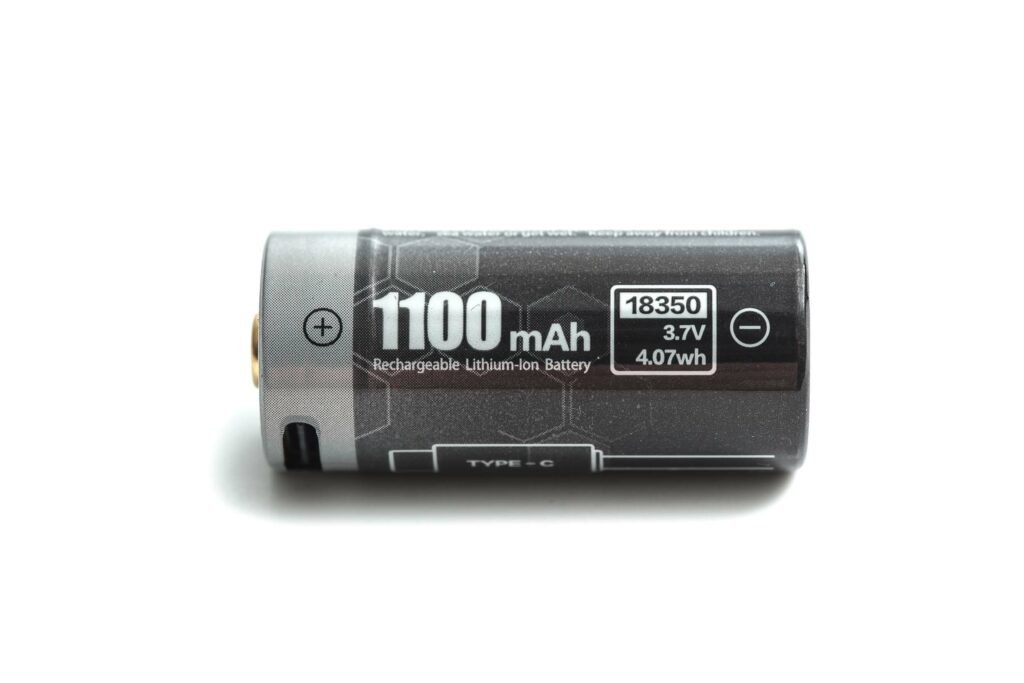
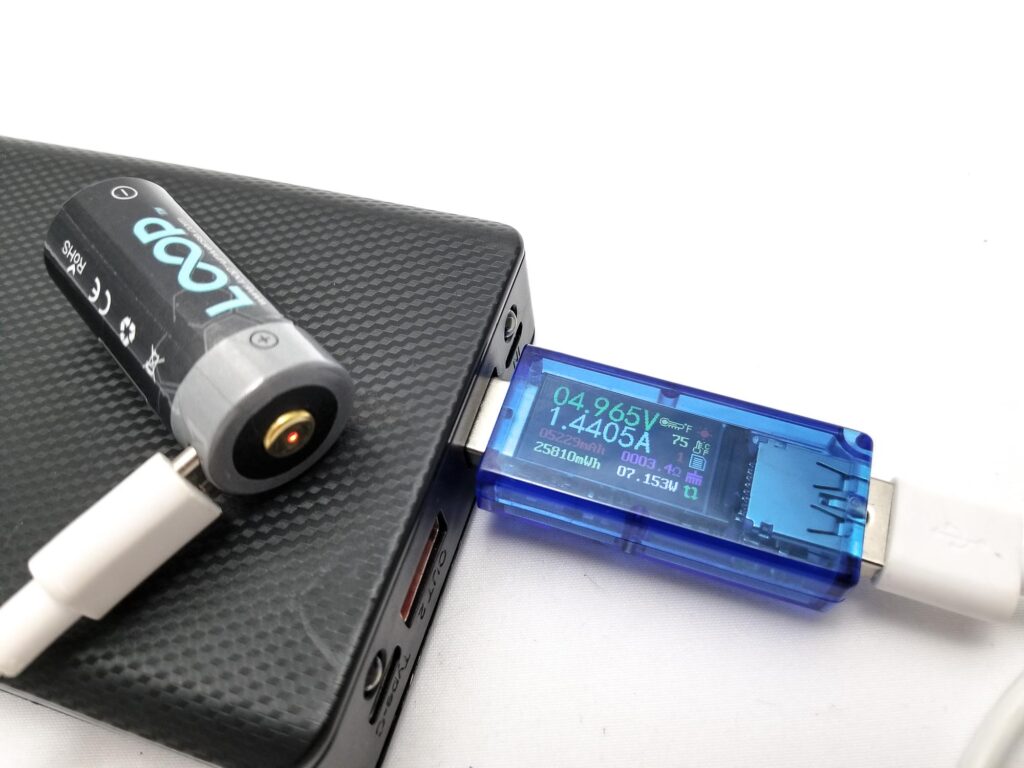
Performance test
Lumen measurements
How Lumens are Measured: Understanding ANSI FL1 Standards How Lumens are Measured: Understanding ANSI FL1 Standards: The ANSI FL1 standards specify that output in lumens should be measured 30 seconds after turning on, as this is the standardized time for measuring brightness according to the industry standard. This is why we focus on this part in our measurements. The ANSI FL1 standards require an ambient temperature of 22 ± 3°C. We record the ambient the ambient temperature to identify potential reasons for any observed discrepancies.Lumens are measured in my 30 cm integrating sphere with a Digi-Sense 20250-00 data logging luxmeter. The sphere has been calibrated with a Convoy S2+ measured to 260 Lumens and the figures are within 10% of actual. I used the fully charged included battery for the test. No current measurements this time.
Lumen measurements (for each mode)
| Mode | Specs | turn on | 30 sec | 10 minutes |
|---|---|---|---|---|
| Eco | 5 | 1.3 lm | 1.3 lm | – |
| Low | 150 | 164 lm | 160 lm | 153 lm |
| High | 600 | 440 lm | 422 lm | 370 lm |
| Turbo | 1600 | 1196 lm | 739 lm | 264 lm |
Parasitic drain:
- Not measured
The outputs are coming in way lower than advertised, save for the Low spec, which is coming in…high. It’s pretty typical for a small 18350 size light, but a bit worse than the competition for sustained output, as we’ll see in the next set of runtimes.
Loop Universe SK01s LED Battery Life: Runtime graphs
How Runtimes are Measured: Understanding ANSI FL1 Standards About ANSI FL1 runtime standards: The runtime is measured until the light drops to 10% of its initial output (30 seconds after turning on). This does not mean that the flashlight is not usable anymore. The last column shows how long the light actually works till it shuts off. If there is a + symbol, it means that the test was stopped at that particular point, but the light was actually still running. This happens on certain occasions, with certain drivers, firmware, or batteries.Runtimes are measured in my 30 cm integrating sphere with a Digi-Sense 20250-00 data logging luxmeter. The sphere has been calibrated with a Convoy S2+ measured to 260 Lumens and the figures are within 10% of actual. I measure temperature readings with my Digi-Sense 20250-92 data logging thermocouple. The thermocouple is affixed to the head with kapton tape, and I used the same 5 second sampling rate as the luxmeter. I used the included battery for the test. I only recorded the temperatures for Turbo since it barely warmed up.
| Mode | Specified runtime | Measured runtime ANSI | Time till shut off |
|---|---|---|---|
| Low | 3h 55m | 4h 7m | 4h 10m |
| High | 1h 5m | 59m 40sec | 59m 40sec |
| Turbo | 30 sec+1h | 38m | 38m 40sec |
The Loop is using an unregulated driver, which is a bummer in a light that costs $200. There’s probably a PWM controlled FET and a 7135 regulator at work here since the output follows the battery voltage as it discharges. The runtime specs are mostly close, but the Turbo runtime is a bit truncated. The timed step down comes around 20 seconds, and it’s deep: from 1000+ Lumens to about 300. It camps there for a while and slowly decreases. It doesn’t seem to be thermal regulated. The host never really heats up in any appreciable way anyways and I imagine the thermal path isn’t the greatest.. Like all 18350 lights, the runtimes on higher modes are short. The other runtimes are pretty standard. The host never heats up much here either. Barely above ambient for High mode.

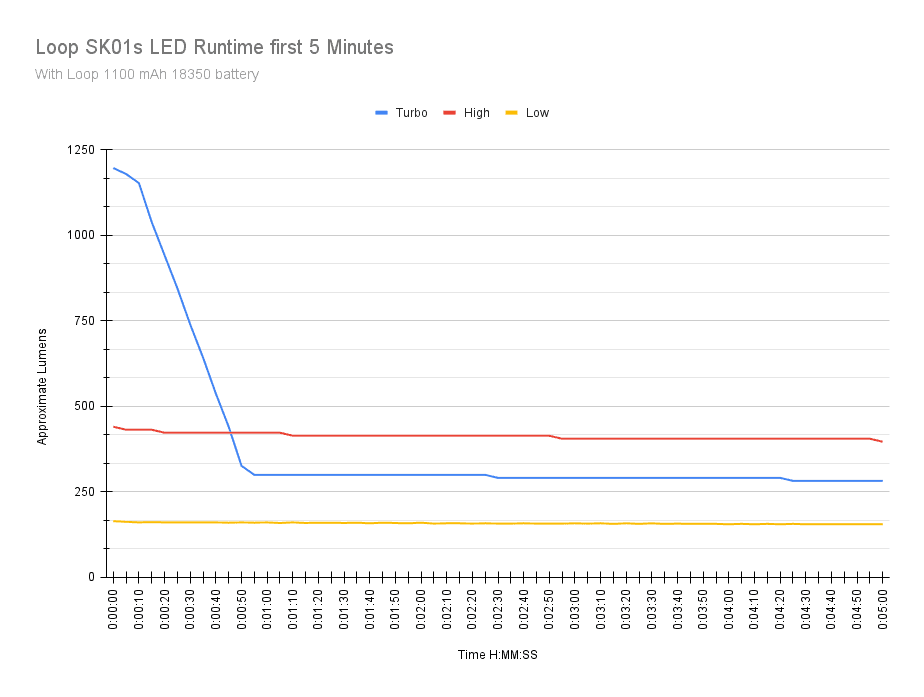
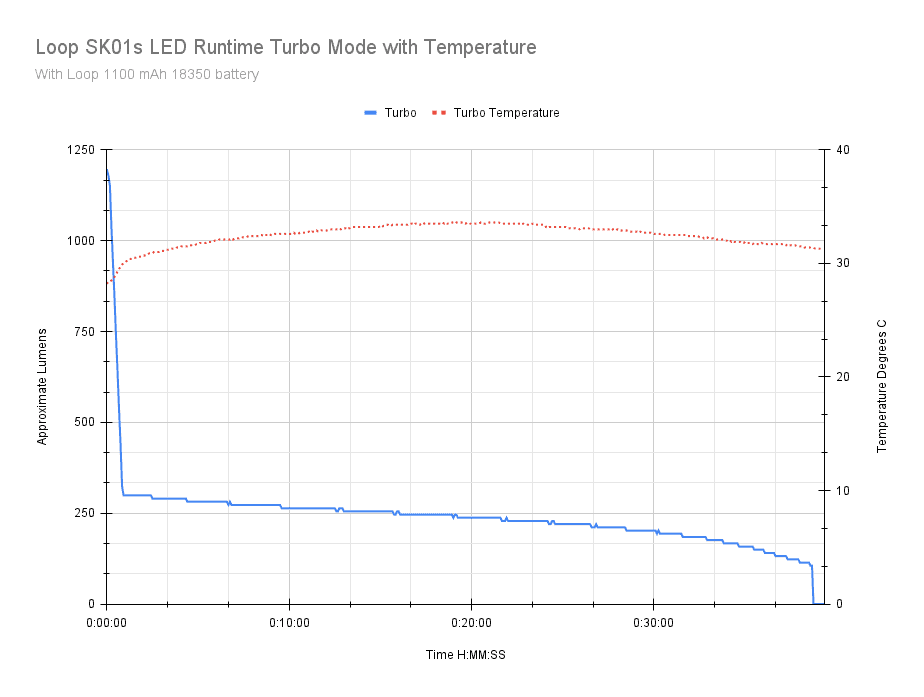
Here’s another graph, comparing the performance of several flashlights:
- Loop SK01s LED
- Manker MC13II
- Wuben D1
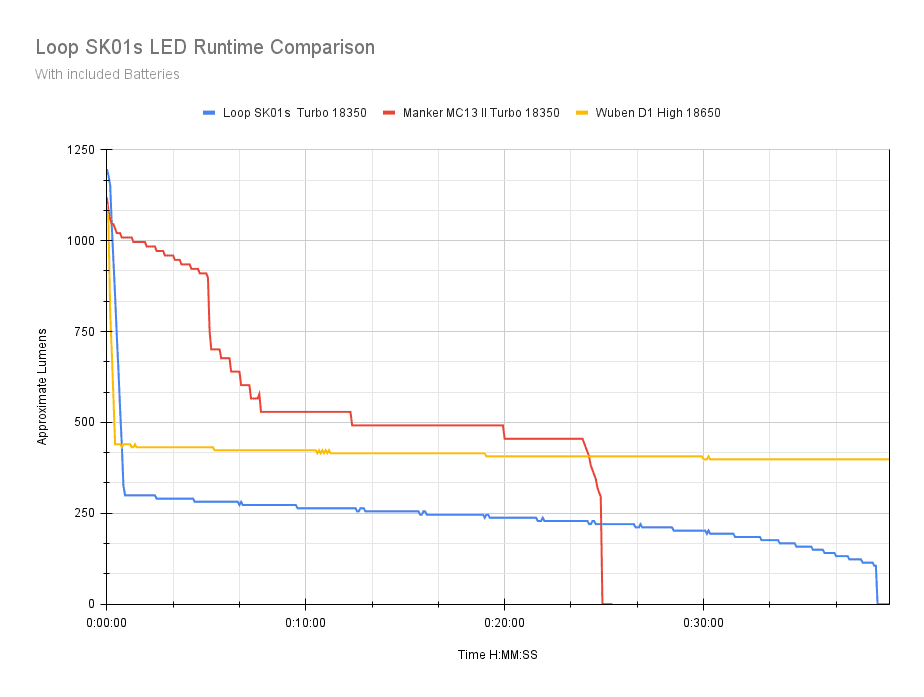
Peak beam intensity and beam distance measurements
About Peak beam intensity: Understanding ANSI FL1 Standards About peak beam intensity The calculated value of distance in meters at which the flashlight produces a light intensity of 0.25 lux. (0.25 lux is about the brightness of a full moon shining on an object). This means that the intensity has decreased so much, it becomes difficult to see darker objects, or objects that don’t reflect light. The columns ‘Meters’ and ‘Yards’ use rounded numbers.The beam distance test was conducted using the Uni-t UT383S luxmeter at a distance of 5 meters. I used the included battery for the test. Measurements taken at 30 seconds per ANSI spec.
| Mode | Specs | Candela measured | Meters | Yards |
|---|---|---|---|---|
| Eco | ? | 75 | 17 | 19 |
| Low | ? | 5550 | 149 | 163 |
| High | ? | 14,925 | 244 | 267 |
| Turbo | 62,500 cd | 41,700 cd | 408 | 446 |
Loop didn’t list any throw figures for the first 3 modes, but does list a single figure of 62,500 cd, which I assume is for Turbo. Even at turn on, the specs are below the advertised. Usually I don’t split hairs over 50 meters, but this quite a bit. Not surprising, since by the 30 second mark, the output is already dropping slowly. The specs aren’t too impressive for a SFT-40-W behind a 30+mm TIR.
Beamshots
Photos taken with my Samsung Note 8 set to 0.3s ISO 200 and 5000K WB. The fence is 40 meters distant.
Beamshots of the following flashlights compared:
- Loop SK01S LED
- Wuben D1
- Manker MC13 II
- Acebeam L17
- Manker E14 IV
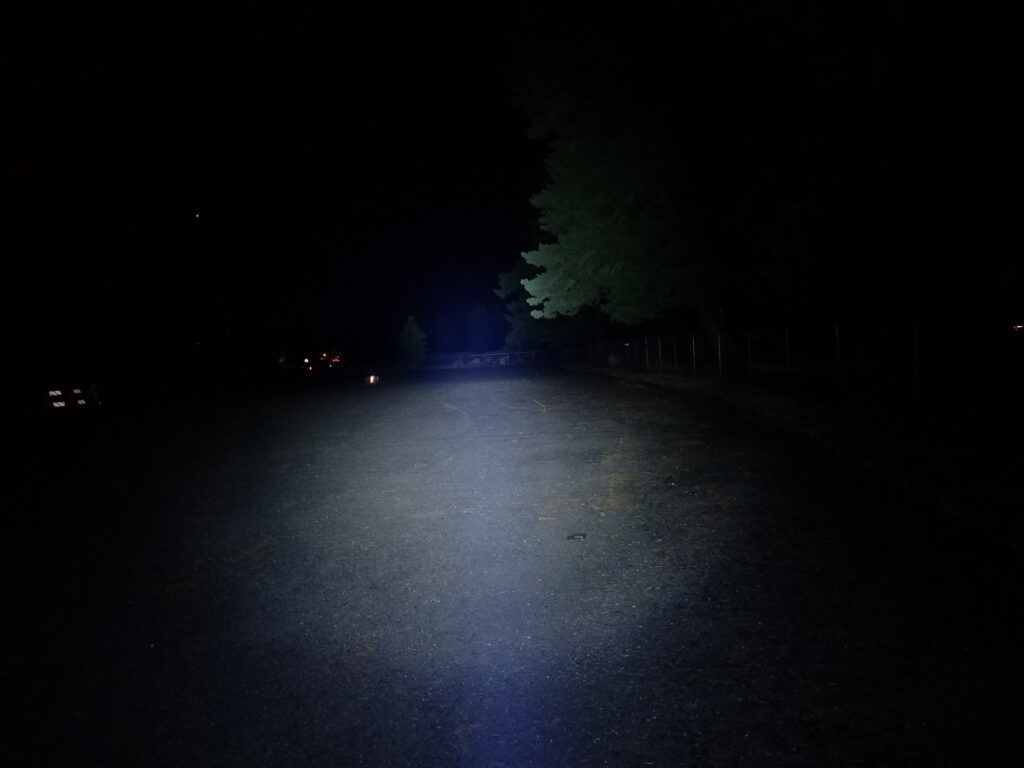

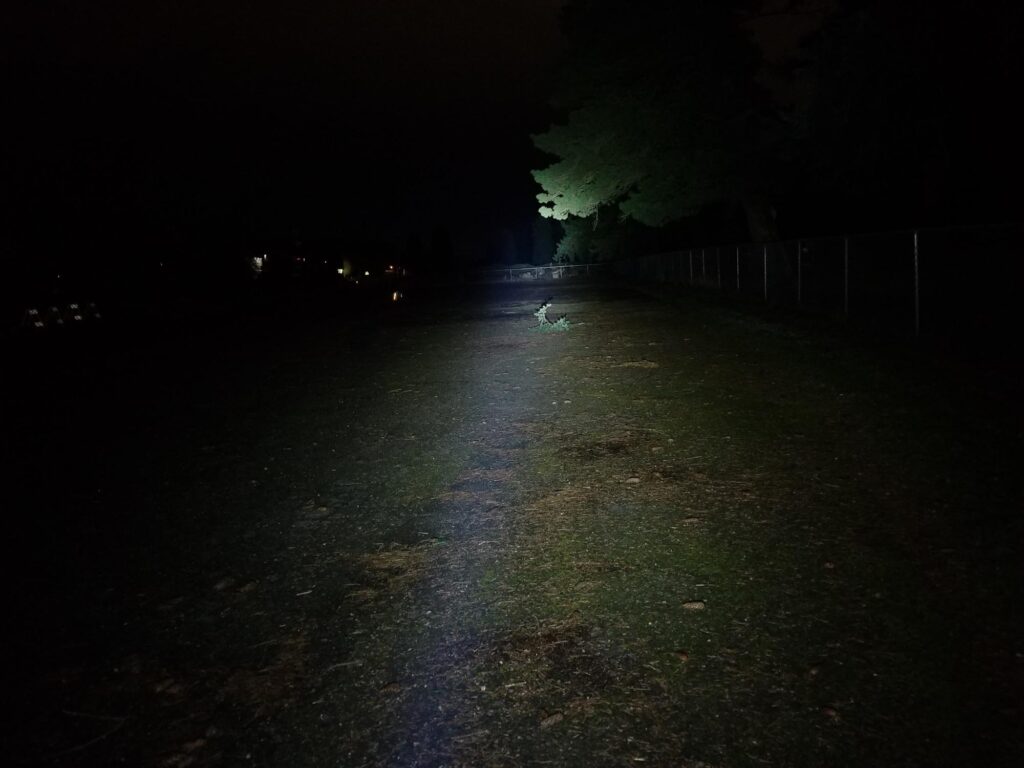
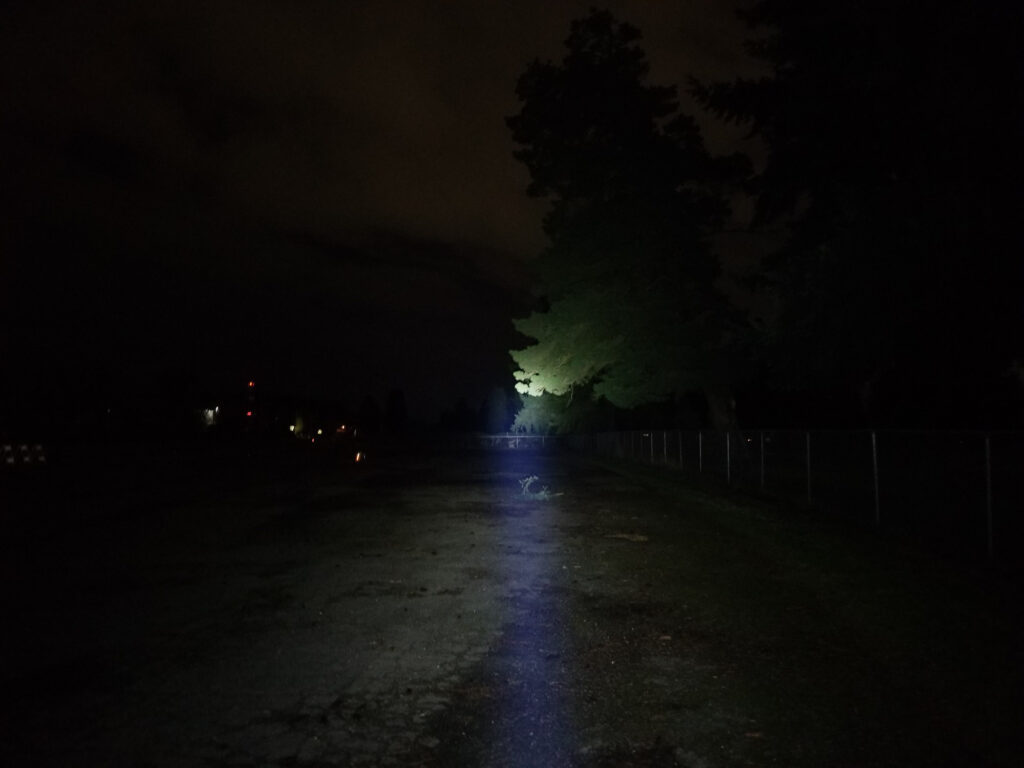

Disclaimer: This flashlight was sent to me for review at no cost by Loop Universe. I have not been paid to review, nor have I been holding back on problems or defects.
Final Verdict
Pros
- Very nice build quality, fit and finish
- Lots and lots of fidgety fun features
- Decent beam distance
- Can use standard 18350 batteries
Cons
- Aux LEDs are a bit overkill and way too bright
- Switch could be improved-feels a bit mushy
- Handling is not great
- Unsuitable for EDC
- Unregulated driver
Explanation on star ratings:
1: Avoid: a match would be a better choice – 2: Poor: significant defect or issues; almost unusable – 3: Average: some defects or issues; but still usable 4: Good: recommended (minor issues) – 5: Great: highly recommended

3 stars: ★★★
While our star rating provides a reliable indicator, we encourage you to read the full review to make an informed decision based on your own needs and preferences.
This is my first what I’d consider to be a ‘feature’ flashlight. In fact, it’s more ‘features’ than flashlight, like a fidget toy that has a flashlight attached to it…a 500 meter throw flashlight. However, and this is a big however, I had a tough time with my rating for the Loop SK01s for a couple reasons. First, this thing is just plain fun to play with. I caught myself fidgeting it while lying in bed, on the couch, and when my mind had nowhere else to go. It’s a really nicely designed and sculpted flashlight-nothing else looks like the SK01s. In that respect, it gets 5 stars. However, the fidgety bits also have a flashlight attached to them, and this is where the Loop falls a bit short. As an 18350 size EDC piece, it’s not great. Those fidget bits mostly just add bulk, weight, and upset the handling dynamics. The stepdowns are way too quick (even for an 18350 light), and the sustained output isn’t great either. Compared to the $65 Manker MC13 II, Thrunite Catapult Mini, and even the Wurkkos TS11, the SK01s doesn’t represent a compelling alternative. The switch action isn’t the best, and didn’t help the weird handling. While I like interesting features and give Loop major kudos for being adventurous here, I think the aux LED lightshow is a bit overkill and mostly unnecessary. I didn’t care for them on the Wurkkos TS25 and it’s the same here. At least they aren’t active when the light is on (well, the ones in the head). The ‘bright’ spots here? For a TIR, I enjoyed the side illumination and beam distance. I also like the regulated output, the superb build quality and attention to detail, and the fact they included a non proprietary battery. The bottom line? If you’re looking for an EDC piece, there are way better choices out there than the Loop SK01s. However, I think if you’re a fidget fan, have some disposable income, and want one of the most unique flashlights out right now, the Loop SK01s might be right up your alley. 3 stars for the Loop SK01s LED as a flashlight, and 5 stars as a fidget.
Buy your Loop Universe SK01s LED here:
1lumen selects and reviews products personally. We may earn affiliate commissions through our links, which help support our testing.